Early Priabonian Larger Benthic Foraminifera in the Vicinity of Verona (N Italy)
Abstract
1. Introduction
2. Geological Setting
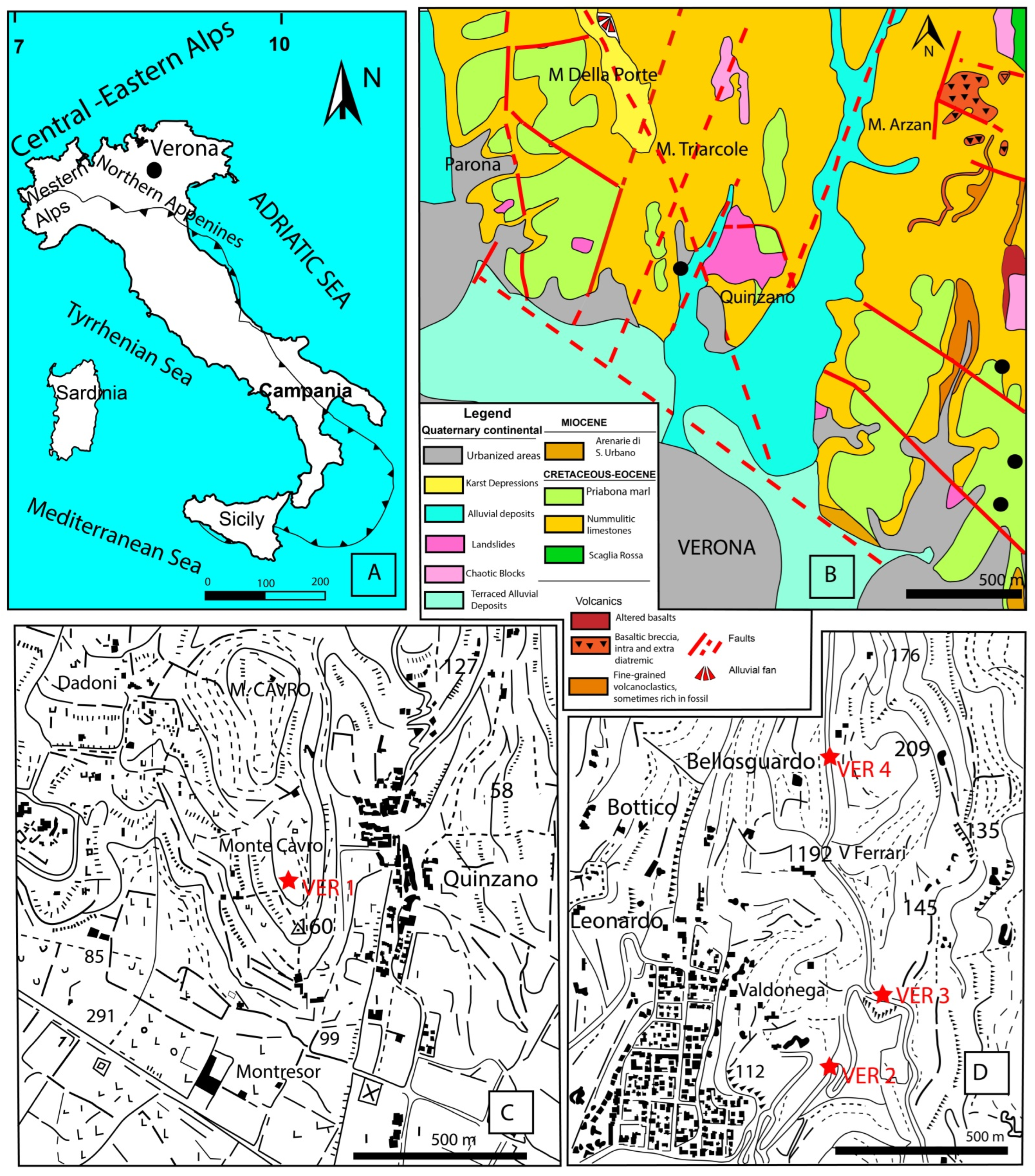
3. Previous LBF Studies in the Vicinity of Verona
4. Materials and Methods
4.1. Localities
4.2. Preparation and Depository
4.3. Taxon Determination
5. Results
6. Systematical Part
- Order Foraminiferida Eichwald, 1830
6.1. Orthophragmines
- p and d: Outer diameter of the protoconch and deuteroconch perpendicular to their common axis (in µm);
- I and J: Outer circumference of the protoconch embraced (I) and not embraced (J) by the deuteroconch;
- N: Number of the adauxiliary chamberlets (in Figure 7, N =15);
- H: Characteristic height of undeformed adauxiliary chamberlets (in µm);
- n: Characteristic number of annuli within 0.5 mm distance measured from the edge of the deuteroconch (in Figure 7, n ≈ 6.7);
- w: Characteristic width of the equatorial chamberlets around the peripheral part of the equatorial layer (in µm).
- A: Degree of embracement of the protoconch by the deuteroconch (in %) calculated as A = 100 × I/(I + J);
- W: Estimated width of the adauxiliary chamberlets (in µm) calculated as W = [(d + H) × π − p]/(N + 1);
- F: Estimated shape of the adauxiliary chamberlets (in %) calculated as F = 100 × H/(H + W);
- h: Estimated height of the equatorial chamberlets close to the embryo (in µm) calculated as h = (500 − H)/(n − 1);
- G: Estimated shape of the equatorial chamberlets close to the embryo (in %) calculated as G = 100 × h/(h + w).
6.1.1. Family Discocyclinidae Galloway, 1928
Genus Discocyclina Gümbel, 1870
- 1.
- Discocyclina augustae van der Weijden, 1940
- Discocyclina augustae augustae van der Weijden, 1940
- 2.
- Discocyclina dispansa (Sowerby, 1840)
- Discocyclina dispansa dispansa (Sowerby, 1840)
- 3.
- Discocyclina euaensis Whipple, 1932
- 4.
- Discocyclina pratti (Michelin, 1846)
- Discocyclina pratti minor Meffert, 1931
- 5.
- Discocyclina radians (d’Archiac, 1850)
- 6.
- Discocyclina trabayensis Neumann, 1955
- Discocyclina trabayensis elazigensis Özcan et Less, 2006
Genus Nemkovella Less, 1987
- 7.
- Nemkovella strophiolata (Gümbel, 1870)
- Nemkovella strophiolata tenella (Gümbel, 1870)
- 8.
- Nemkovella daguini (Neumann, 1958)
6.1.2. Family Orbitoclypeidae Brönnimann, 1945
Genus Orbitoclypeus Silvestri, 1907
- 9.
- Orbitoclypeus varians (Kaufmann, 1867)
Orbitoclypeus varians scalaris (Schlumberger, 1903)
Orbitoclypeus varians varians (Kaufmann, 1867)
Genus Asterocyclina Gümbel, 1870
- 10.
- Asterocyclina alticostata (Nuttall, 1926)
Asterocyclina alticostata danubica Less, 1987
- 11.
- Asterocyclina stellata (d’Archiac, 1846)
- Asterocyclina stellata stellaris (Brünner in Rütimeyer, 1850)
6.2. Family Nummulitidae de Blainville, 1827
6.2.1. Genus Nummulites Lamarck, 1801
- P: Inner cross-diameter of the proloculus;
- d: Outer diameter of the two first whorls along the axis of the embryo;
- E: Total number of chambers in the first two whorls (excluding the first two chambers). In Figure 28, these chambers are marked by • (E = 19);
- M: Inner diameter of the first three whorls along the axis of the embryo;
- D: Outer diameter of the first three whorls along the axis of the embryo;
- N: Exact number of chambers in the third whorl. In Figure 28, these chambers are marked by * (N = 13.6).
- L: L = d × π/N—estimated average length of chambers in the third whorl (in µm);
- K: K = 100 × (D − d)/(D − P)—index of spiral opening (in %) expressed by the ratio of the height of the third whorl vs. the height of the first three whorls (without the proloculus);
- F: F = 100 × [(D − d)/2]/[(D − d)/2 + L]—estimated isometry index (“shape”) of chambers in the third whorl (in %);
- m: m = 100×(D − M)/(D − d)—relative width of the spiral cord in the third whorl (in %).
- 12.
- Nummulites hormoensis Nuttall & Brighton, 1931
- 13.
- Nummulites fabianii (Prever in Fabiani, 1905)
- 14.
- Nummulites budensis Hantken, 1875
- 15.
- Nummulites chavannesi de la Harpe, 1878
- 16.
- Nummulites incrassatus de la Harpe, 1883
- 17.
- Nummulites pulchellus Hantken in de la Harpe, 1883
6.2.2. Genus Assilina d’Orbigny, 1839
Assilina alpina (Douvillé, 1916)
6.2.3. Genus Operculina d’Orbigny, 1826
Operculina ex gr. gomezi Colom et Bauzá, 1950
6.2.4. Genus Heterostegina d’Orbigny, 1826
Heterostegina reticulata Rütimeyer, 1850
Heterostegina reticulata multifida (Bieda, 1949)
Heterostegina reticulata mossanensis Less, Özcan, Papazzoni & Stockar, 2008
6.2.5. Genus Spiroclypeus Douvillé, 1905
Spiroclypeus sirottii Less & Özcan, 2008
7. Discussion
7.1. Comparison with Other LBF Key Assemblages
7.2. Updating Late Lutetian–Priabonian LBF Range Charts
Author Contributions
Funding
Data Availability Statement
Acknowledgments
Conflicts of Interest
Abbreviations
| SBZ | Shallow Benthic Zone |
| LBF | Larger benthic foraminifera |
| OZ | Orthophragmine Zone |
| Fm. | Formation |
| № | Number of specimens |
| s.e. | Standard error |
| HO | Highest occurrence |
References
- Coletti, G.; Commissario, L.; Mariani, L.; Bosio, G.; Desbiolles, F.; Soldi, M.; Bialik, O.M. Palaeocene to Miocene southern Tethyan carbonate factories: A meta-analysis of the successions of South-western and Western Central Asia. Depos. Rec. 2022, 8, 1031–1054. [Google Scholar] [CrossRef]
- Archiac, E.J.A.d’. Description des Fossiles du Groupe Nummulitique Recueillis Par M. S. P. Pratt et M. J. Delbos Aux Environs de Bayonne et de Dax. In Mémoires de la Société Géologique de France, 2nd series 1850 ed; Société géologique de France: Paris, France, 1850; Volume 3, pp. 397–456. (In French) [Google Scholar]
- Archiac, E.J.A.d’.; Haime, J. Description des Animaux Fossils du Groupe Nummulitique de l’Inde, Précédé D’un Résumé Géologique et D’une Monographie des Nummulites; Gide et J. Baudry Libraires-Éditeurs: Paris, France, 1853. (In French) [Google Scholar]
- Serra-Kiel, J.; Hottinger, L.; Caus, E.; Drobne, K.; Ferrández, C.; Jauhri, A.K.; Less, G.; Pavlovec, R.; Pignatti, J.; Samsó, J.M.; et al. Larger Foraminiferal Biostratigraphy of the Tethyan Paleocene and Eocene. Bull. Soc. Géol. Fr. 1998, 169, 281–299. [Google Scholar]
- Cahuzac, B.; Poignant, A. Essai de Biozonation de l’Oligo-Miocène Dans Les Bassins Européens à l’aide Des Grands Foraminifères Néritiques. Bull. Soc. Géol. Fr. 1997, 168, 155–169. [Google Scholar]
- Less, G. Paleontology and stratigraphy of the European Orthophragminae. Geol. Hung. Ser. Palaeontol. 1987, 51, 1–373. [Google Scholar]
- Less, G. The zonation of the Mediterranean Upper Paleocene and Eocene by Orthophragminae. Opera Dela Slov. Akad. Znan. Umet. 1998, 34, 21–43. [Google Scholar]
- Özcan, E.; Yücel, A.O.; Erkızan, L.S.; Gültekin, M.N.; Kayğılı, S.; Yurtsever, S. Atlas of the Tethyan Orthophragmines. Mediterr. Geosci. Rev. 2022, 4, 3–213. [Google Scholar] [CrossRef]
- Papazzoni, C.A.; Ćosović, V.; Briguglio, A.; Drobne, K. Towards a calibrated larger foraminifera biostratigraphic zonation: Celebrating 18 years of the application of shallow benthic zones. Palaios 2017, 32, 1–5. [Google Scholar] [CrossRef]
- Pignatti, J.; Papazzoni, C.A. Oppelzones and their heritage in current larger foraminiferal biostratigraphy. Lethaia 2017, 50, 369–380. [Google Scholar] [CrossRef]
- Doglioni, C.; Bosellini, A. Eoalpine and Mesoalpine tectonics in the Southern Alps. Geol. Rundsch. 1987, 76, 735–754. [Google Scholar] [CrossRef]
- Carminati, E.; Doglioni, C. Alps vs. Apennines: The paradigm of a tectonically asymmetric Earth. Earth-Sci. Rev. 2012, 112, 67–96. [Google Scholar] [CrossRef]
- Curzi, M.; Viola, G.; Zuccari, C.; Aldega, L.; Billi, A.; van der Lelij, R.; Kylander-Clark, A.; Vignaroli, G. Tectonic evolution of the Eastern Southern Alps (Italy): A reappraisal from new structural data and geochronological constraints. Tectonics 2024, 43, e2023TC008013. [Google Scholar] [CrossRef]
- Bosellini, A. Dynamics of Tethyan carbonate platforms. In Controls on Carbonate Platform and Basin Development; Crevello, P.D., Wilson, J.L., Sarg, J.F., Read, J.F., Eds.; SEPM Special Publication; Society for Sedimentary Geology (SEPM): Claremore, OK, USA, 1989; Volume 44, pp. 3–13. [Google Scholar]
- Zampieri, D. Tertiary extension in the Southern Trento Platform, Southern Alps, Italy. Tectonics 1995, 14, 645–657. [Google Scholar] [CrossRef]
- Winterer, E.L.; Bosellini, A. Subsidence and sedimentation on Jurassic passive continental margin, Southern Alps, Italy. AAPG Bull. 1981, 65, 394–421. [Google Scholar] [CrossRef]
- Luciani, V. Stratigrafia sequenziale del Terziario nella catena del Monte Baldo (provincie di Verona e Trento). Mem. Sci. Geol. 1989, 41, 263–351. [Google Scholar]
- Rasser, M.W.; Harzhauser, M.; Anistratenko, O.Y.; Anistratenko, V.V.; Bassi, D.; Belak, M.; Berger, J.-P.; Bianchini, G.; Čičić, S.; Ćosović, V. Palaeogene and Neogene. In The Geology of Central and Eastern Europe; McCann, T., Ed.; Geological Society of London: London, UK, 2008; pp. 1031–1137. [Google Scholar]
- Martire, L.; Clari, P.; Lozar, F.; Pavia, G. The Rosso Ammonitico Veronese (Middle-Upper Jurassic of the Trento Plateau): A Proposal of Lithostratigraphic Ordering and Formalization. Riv. Ital. Paleontol. Stratigr. 2006, 112, 227. [Google Scholar]
- Roghi, G.; Romano, R. Le Formazioni Geologiche del Veronese nella Nuova Cartografia Geologica Nazionale. La Lessinia—Ieri Oggi Domani. Quaderno Culturale 2009, 32, 34–35. [Google Scholar]
- Bosellini, A.; Carraro, F.; Corsi, M.; De Vecchi, G.; Gatto, G.; Malaroda, R.; Sturani, C.; Ungaro, S.; Zanettin, B. Note Illustrative Della Carta Geologica d’Italia; F. 49, Verona; Servizio Geologico d’Italia: Roma, Italy, 1967. [Google Scholar]
- Zorzin, R. Geologia e paleontologia dell’area collinale di Verona. In Storia Naturale Della Città di Verona—Mem. Mus. Civ. St. Nat. Verona, Monografie Naturalistiche 6, 2021; Latella, L., Ed.; Cierre Edizioni: Sommacampagna, Italy, 2018; pp. 39–48. [Google Scholar]
- De Zanche, V.; Sorbini, L.; Spagna, V. Geologia del territorio del Comune di Verona. In Memorie Museo Civico Storia Naturale Verona, II Serie, Sez. Sci. Terra; Museo di Storia Naturale di Verona: Verona, Italy, 1977; Volume 1, pp. 1–52. [Google Scholar]
- Barbieri, G. I Macroforaminiferi dell’Eocene Superiore nei Lessini a Nord di Verona. Bachelor’s Thesis, Università degli Studi di Modena—Istituto di Paleontologia, Modena, Italy, 1985; pp. 1–198. [Google Scholar]
- Papazzoni, C.A.; Sirotti, A. Nummulite biostratigraphy at the Middle/Upper Eocene boundary in the Northern Mediterranean Area. Riv. Ital. Paleontol. Stratigr. 1995, 101, 63–80. [Google Scholar]
- Fabiani, R. Guida geologica delle Colline di Verona. Atti Accad. Agricolt. Sci. Lett. Verona 1920, 21, 241–252. [Google Scholar]
- Catullo, A. Memoria geognostico-paleozoica sulle Alpi Venete, con Appendice e Seconda Appendice al Catalogo degli Ammoniti delle Alpi Venete. Mem. Soc. Ital. Sci. Res. Modena 1848, 24, 187–339. [Google Scholar]
- Bittner, A. Das Alpengebiet zwischen Vicenza und Verona. Verh. Geol. Bundesanst. 1877, 8, 226–231. [Google Scholar]
- Oppenheim, P. Die Eocaenfauna des Monte Postale bei Bolca in Veronesischen. Palaeontographica 1896, 43, 125–222. [Google Scholar]
- Fabiani, R. Il Paleogene del Veneto. Mem. Istit. Geol. Univ. Padova 1915, 3, 1–336. [Google Scholar] [CrossRef]
- Brönnimann, P. Zur Morphologie von Aktinocyclina Gümbel 1868. Eclogae Geol. Helv. 1945, 38, 560–579. [Google Scholar]
- Brönnimann, P. Zur Frage der verwandtschaftlichen Beziehungen zwischen Discocyclina s.s. und Asterocyclina. Eclogae Geol. Helv. 1945, 38, 579–617. [Google Scholar]
- Hottinger, L. Recherches sur les Alvéolines paléocènes et éocènes. Schweiz. Paläontol. Abh. 1960, 75–76, 1–243 + Atlas. [Google Scholar]
- Schaub, H. Contribution à la stratigraphie du Nummulitique du Véronais et du Vicentin. Mem. Soc. Geol. Ital. 1962, 3, 59–66. [Google Scholar]
- Schaub, H. Nummulites et Assilinae de la Tethys Paléogène: Taxonomies, phylogenèse et biostratigraphie. Schweiz. Paläontol. Abh. 1981, 104–106, 1–236 + Atlas I–II. [Google Scholar]
- Arni, P.; Lanterno, E. Considérations paléoécologiques et interprétation des calcaires de l’Éocène du Véronais. Arch. Sci. 1972, 25, 251–283. [Google Scholar]
- Less, G.; Özcan, E.; Papazzoni, C.A.; Stockar, R. The Middle to Late Eocene Evolution of Nummulitid Foraminifer Heterostegina in the Western Tethys. Acta Palaeontol. Pol. 2008, 53, 317–350. [Google Scholar] [CrossRef]
- Less, G.; Özcan, E. The Late Eocene Evolution of Nummulitid Foraminifer Spiroclypeus in the Western Tethys. Acta Palaeontol. Pol. 2008, 53, 303–316. [Google Scholar] [CrossRef]
- Less, G. New method for the examination of equatorial sections of orbitoidal larger foraminifera. In Magyar Állami Földtani Intézet Évi Jelentése 1979; Magyar Állami Földtani Intézet: Budapest, Hungary, 1981; pp. 1445–1457. [Google Scholar]
- Hottinger, L. Foraminifères operculiniformes. Mém. Mus. Natl. Hist. Nat. 1977, 57, 1–159. [Google Scholar]
- Drobne, K. Alvéolines paléogènes de la Slovénie et de l’Istrie. Schweiz. Paläontol. Abh. 1977, 99, 1–132. [Google Scholar]
- Drooger, C.W. Radial Foraminifera: Morphometrics and Evolution. Verh. Kon. Ned. Akad. Wetensch., Afd. Natuurk. 1993, 41, 1–242. [Google Scholar]
- Khan, M.A.; Drooger, C.W. On variation in Nummulites assemblages. I and II. Proc. Kon. Ned. Akad. Wetensch. B 1971, 72, 97–121. [Google Scholar]
- Less, G.; Kovács, L.Ó. Typological versus morphometric separation of orthophragminid species in single samples—A case study from Horsarrieu (upper Ypresian, SW Aquitaine, France). Rev. Micropaléontol. 2009, 52, 267–288. [Google Scholar] [CrossRef]
- Less, G.; Özcan, E. Bartonian–Priabonian larger benthic foraminiferal events in the Western Tethys. Austrian J. Earth Sci. 2012, 105, 129–140. Available online: https://www.zobodat.at/pdf/MittGeolGes_105_1_0129-0140.pdf (accessed on 1 August 2025).
- Agnini, C.; Fornaciari, E.; Giusberti, L.; Grandesso, P.; Lanci, L.; Luciani, V.; Muttoni, G.; Pälike, H.; Rio, D.; Spofforth, D.J.A.; et al. Integrated biomagnetostratigraphy of the Alano section (NE Italy): A proposal for defining the middle–late Eocene boundary. Bull. Geol. Soc. Am. 2011, 123, 841–872. [Google Scholar] [CrossRef]
- Agnini, C.; Backman, J.; Boscolo-Galazzo, F.; Condon, D.J.; Fornaciari, E.; Galeotti, S.; Giusberti, L.; Grandesso, P.; Lanci, L.; Luciani, V.; et al. Proposal for the global boundary stratotype section and point (GSSP) for the Priabonian stage (Eocene) at the Alano section (Italy). Episodes 2021, 44, 151–173. [Google Scholar] [CrossRef]
- Caudri, C.B. Systematics of the American Discocyclinas. Eclogae Geol. Helv. 1972, 65, 211–219. [Google Scholar] [CrossRef]
- Ferràndez-Cañadell, C.; Serra-Kiel, J. Morphostructure and paleobiology of Discocyclina Gümbel, 1870. J. Foraminifer. Res. 1992, 22, 147–165. [Google Scholar] [CrossRef]
- Ferràndez-Cañadell, C. A new, ribbed species of Nemkovella Less 1987 (Discocyclinidae), and discussion of the genus Actinocyclina Gümbel, 1870. J. Foraminifer. Res. 1997, 27, 175–185. [Google Scholar] [CrossRef]
- Ferràndez-Cañadell, C. An asterigerinacean origin for Orbitoclypeus and Asterocyclina (Orbitoclypeidae, Foraminifera). J. Foraminifer. Res. 1998, 28, 135–140. [Google Scholar]
- Özcan, E.; Mitchell, S.F.; Less, G.; Robinson, E.; Bryan, J.R.; Pignatti, J.; Yücel, A.O. A revised suprageneric classification of American orthophragminids with emphasis on late Paleocene representatives from Jamaica and Alabama. J. Syst. Palaeontol. 2019, 17, 1551–1579. [Google Scholar] [CrossRef]
- Özcan, E.; Less, G.; Báldi-Beke, M.; Kollányi, K.; Kertész, B. Biometric analysis of middle and upper Eocene Discocyclinidae and Orbitoclypeidae (Foraminifera) from Turkey and updated orthophragmine zonation in the western Tethys. Micropaleontology 2006, 52, 485–520. [Google Scholar] [CrossRef]
- Ferràndez-Cañadell, C.; Baumgartner-Mora, C.; Baumgartner, P.O.; Epard, J.-L. Priabonian (upper Eocene) larger foraminifera from the Helvetic Nappes of the Alps (Western Switzerland): New markers for Shallow Benthic Zones 19–20. Micropaleontology 2023, 69, 401–450. [Google Scholar] [CrossRef]
- van der Weijden, W.J.M. Het Genus Discocyclina in Europa: Een Monografie Naar Aanleiding Van Een Heronderzoek Van Het Tertiair-Profiel Van Biarritz; N.V. de Leidsche Courant: Utrecht, The Netherlands, 1940. [Google Scholar]
- Less, G. The late Paleogene larger foraminiferal assemblages of the Bükk Mts. (NE Hungary). Rev. Esp. Micropaleontol. 1999, 31, 51–60. [Google Scholar]
- Sowerby, J.; De, C. Systematic list of organic remains, the plants determined by Mr. John Morris, and the remainder by Mr. James de Carl Sowerby. Trans. Geol. Soc. Lond. Ser. 2 1840, 5, 327–329. [Google Scholar]
- Samanta, B.K.; Lahiri, A. The occurrence of Discocyclina Gümbel in the middle Eocene Fulra Limestone of Cutch, Gujarat, Western India, with notes on species reported from the Indian region. Bull. Geol. Min. Metall. Soc. India 1985, 52, 211–295. [Google Scholar]
- Özcan, E.; Less, G.; Okay, A.I.; Báldi-Beke, M.; Kollányi, K.; Yılmaz, İ.Ö. Stratigraphy and larger foraminifera of the Eocene shallow-marine and olistostromal units of the southern part of the Thrace Basin, NW Turkey. Turk. J. Earth Sci. 2010, 19, 27–77. [Google Scholar] [CrossRef]
- Özcan, E.; Okay, A.İ.; Bürkan, K.A.; Yücel, A.O.; Özcan, Z. Middle–Late Eocene marine record of the Biga Peninsula, NW Anatolia, Turkey. Geol. Acta 2018, 16, 133–162. [Google Scholar]
- Ali, N.; Özcan, E.; Yücel, A.O.; Hanif, M.; Hashmi, S.I.; Ullah, F.; Pignatti, J. Bartonian orthophragminids with new endemic species from the Pirkoh and Drazinda formations in the Sulaiman Range, Indus Basin, Pakistan. Geodin. Acta 2018, 30, 31–62. [Google Scholar] [CrossRef]
- Özcan, E.; Less, G.; Jovane, L.; Catanzariti, R.; Frontalini, F.; Coccioni, R.; Giorgioni, M.; Rodelli, D.; Rego, E.S.; Kayğılı, S.; et al. Integrated biostratigraphy of the middle to upper Eocene Kırkgeçit Formation (Baskil section, Elazığ, eastern Turkey): Larger benthic foraminiferal perspective. Mediterr. Geosci. Rev. 2019, 1, 55–90. [Google Scholar] [CrossRef]
- Whipple, G.L. Eocene Foraminifera. In Geology of Eua, Tonga; Hoffmeister, I.E., Ed.; Bulletin of the Bernice P. Bishop Museum; Bishop Museum: Honolulu, HI, USA, 1932; Volume 96, pp. 79–90. [Google Scholar]
- Yücel, A.O.; Özcan, E.; Erbil, Ü. Latest Priabonian larger benthic foraminiferal assemblages at the demise of the Soğucak Carbonate Platform (Thrace Basin and Black Sea shelf, NW Turkey): Implications for the shallow marine biostratigraphy. Turk. J. Earth Sci. 2019, 29, 85–114. [Google Scholar] [CrossRef]
- Dimou, V.G.; Koukousioura, O.; Less, G.; Triantaphyllou, M.V.; Dimiza, M.D.; Syrides, G. Systematic paleontology and biostratigraphy of upper Eocene larger benthic foraminifera from Fanari (Thrace Basin, Greece). Micropaleontology 2023, 69, 457–486. [Google Scholar] [CrossRef]
- Less, G.; Özcan, E.; Okay, A.I. Larger foraminiferal stratigraphy and paleoenvironments of the Middle Eocene to Lower Oligocene shallow-marine units in the northern and eastern parts of the Thrace Basin, NW Turkey. Turk. J. Earth Sci. 2011, 20, 793–845. [Google Scholar]
- Meffert, B.F. Eocenovaja fauna iz Daralageza v Armenii. Tr. Glav. Geol.-Razved. Upravl. 1931, 99, 1–64. Leningrad–Moscow. (In Russian) [Google Scholar]
- Zakrevskaya, E.; Less, G.; Bugrova, E.; Shcherbinina, E.; Grigoryan, T.; Sahakyan, L. Integrated biostratigraphy and benthic foraminifera of the middle-upper Eocene deposits of Urtsadzor section (Southern Armenia). Turk. J. Earth Sci. 2020, 29, 896–945. [Google Scholar] [CrossRef]
- Gümbel, C.W. Beiträge zur Foraminiferenfauna der nordalpinen älteren Eocängebilde oder der Kressenberger Nummulitenschichten. Abh. K. Bayer. Akad. Wiss. Math.-Phys. Kl. 1870, 10, 581–730. [Google Scholar]
- Neumann, M. Révision des Orbitoididés du Crétacé et de l’Éocène en Aquitaine Occidentale. Mém. Soc. Géol. Fr. 1958, 37, 1–174. [Google Scholar]
- Özcan, E.; Erbay, S.; Abbasi, A.I.; Pereira, C.D.; Erkızan, L.S.; Kayğılı, S. The first record of Nemkovella daguini (Neumann, 1958) from the middle-late Eocene of Oman (Arabian Peninsula) and Meghalaya (Indian Subcontinent) and its significance in Tethys: Correlations and paleobiogeography. Riv. Ital. Paleontol. Stratigr. 2019, 125, 13–28. [Google Scholar]
- Schlumberger, C. Troisième note sur les Orbitoïdes. Bull. Soc. Géol. Fr. 1903, 4, 273–289. [Google Scholar] [CrossRef]
- Özcan, E.; Saraswati, P.K.; Yücel, A.O.; Ali, N.; Hanif, M. Bartonian orthophragminids from the Fulra Limestone (Kutch, W India) and coeval units in Sulaiman Range, Pakistan: A synthesis of shallow benthic zone (SBZ) 17 for the Indian Subcontinent. Geodin. Acta 2018, 30, 137–162. [Google Scholar] [CrossRef]
- Kaufmann, F.J. Geologische Beschreibung des Pilatus. Beitr. Geol. Kt. Schweiz 1867, 5, 1–169. [Google Scholar]
- Stöckar, R. I macroforaminiferi eocenici negli inclusi dei depositi Quaternari della collina di Prella (Ticino meridionale, Svizzera). Geol. Insubrica 1999, 4, 1–20. [Google Scholar]
- Rütimeyer, L. Ueber das schweizerische Nummulitenterrain, mit besonderer Berücksichtigung des Gebirges zwischen dem Thunersee und der Emme. Neue Denkschr. Schweiz. Naturforsch. Ges. 1850, 11, 1–120. [Google Scholar]
- Romero, J.; Hottinger, L.; Caus, E. Early appearance of larger foraminifera supposedly characteristic for the late Eocene in the Igualada Basin, NE Spain. Rev. Esp. Paleontol. 1999, 14, 79–92. [Google Scholar] [CrossRef]
- Drooger, C.W.; Marks, P.; Papp, A. Smaller radiate Nummulites of northwestern Europe. Utrecht Micropalaeontol. Bull. 1971, 5, 1–137. [Google Scholar]
- Papazzoni, C.A. Biometric analyses of Nummulites “ptukhiani” Z.D. Kacharava, 1969 and Nummulites fabianii (Prever in Fabiani, 1905). J. Foraminifer. Res. 1998, 28, 161–176. [Google Scholar]
- Mukhopadhyay, S.K. Pseudoreticulate-Subreticulate-Reticulate Nummulites and their possible evolution in the middle Eocene-lower Oligocene succession of Surat-Bharuch, Gujarat India. Micropaleontology 2022, 68, 505–556. [Google Scholar] [CrossRef]
- Hadi, M.; Forouzande, S.K.; Consorti, L.; Parandavar, M.; Vahidinia, M. Extending the stratigraphic range of Nummulites bormidiensis Tellini in the Neo-Tethys (Zagros basin, SW Iran) through biometry and calcareous nannofossil biostratigraphy. Micropaleontology 2023, 69, 515–532. [Google Scholar] [CrossRef]
- Yazdi-Moghadam, M.; Sarfi, M.; Sharifi, M.; Jahani, Z. Larger benthic foraminifera and biostratigraphy of the lower Oligocene Asmari Formation: Offshore and onshore southern Iran (Zagros belt). Micropaleontology 2023, 69, 533–548. [Google Scholar] [CrossRef]
- Cotton, L.J.; Pearson, P.N.; Renema, W. A place for Nummulites ptukhiani? A new lineage of reticulate Nummulites from Kilwa District, Tanzania. J. Syst. Palaeontol. 2015, 13, 465–486. [Google Scholar]
- Nuttall, W.L.F.; Brighton, A.G. Larger Foraminifera from the Tertiary of Somaliland. Geol. Mag. 1931, 68, 49–65. [Google Scholar] [CrossRef]
- Fabiani, R. Studii geo-paleontologici dei Colli Berici. Atti R. Ist. Veneto Sci. Lett. Ed Arti 1905, 64, 1805–1825. [Google Scholar]
- Okay, A.İ.; Çolak, D.; Özcan, E. Eocene–Oligocene succession at Kıyıköy (Midye) on the Black Sea coast of Turkey: Stratigraphy, larger benthic foraminifera, and paleoenvironments. Turk. J. Earth Sci. 2020, 29, 1–22. [Google Scholar]
- Hantken, M. von. Die Fauna der 82Clavulina-Szaboi–Schichten. I. Foraminiferen. Mitt. Jahrb. Königl. Ungar. Geol. Anst. 1875, 4, 1–93. (In German) [Google Scholar]
- Nemkov, G.I. Nummulitides of the Soviet Union and their biostratigraphic significance. Mater. K poznan. Geol. Stroen. SSSR 1967, 16, 1–319. (In Russian) [Google Scholar]
- Harpe, P. de la. Note sur les Nummulites des Alpes occidentales. Acta Soc. Helv. Sci. Nat. 1878, 60, 227–232. [Google Scholar]
- Harpe, P. de la. Étude des Nummulites de Suisse et révision des espèces éocènes des genres Nummulites et Assilina. Troisième et dernière partie (Posthume). Mém. Soc. Paléontol. Suisse Abh. Schweiz. Paläontol. Ges. 1883, 10, 141–180. [Google Scholar]
- Herb, R.; Hekel, H. Nummuliten aus dem Obereozän von Possagno. Schweiz. Paläontol. Abh. 1975, 97, 113–135. [Google Scholar]
- Douvillé, H. Le Crétacé et le Tertiaire aux environs de Thônes (Haute-Savoie). C. R. Acad. Sci. Paris 1916, 163, 324–331. [Google Scholar]
- Colom, G.; Bauzá, J. Operculina canalifera gomezi n. subsp. de Bartoniense de Cataluña. Bol. Real Soc. Esp. Hist. Nat. 1950, 47, 219–221. [Google Scholar]
- Özcan, E.; Ali, N.; Hanif, M.; Hashmi, S.I.; Khan, A.; Yücel, A.I.; Abbasi, I.A. New Priabonian Heterostegina from the Eastern Tethys (Sulaiman fold belt, West Pakistan): Implications for the development of Eastern Tethyan heterostegines and their paleobiogeography. J. Foraminifer. Res. 2016, 46, 393–408. [Google Scholar] [CrossRef]
- Drooger, C.W.; Roelofsen, J.W. Cycloclypeus from Ghar Hassan, Malta. Proc. Kon. Ned. Akad. Wetensch. 1982, 85, 203–218. [Google Scholar]
- Bieda, F. Sur quelques foraminifères nouveaux ou peu connus du flysch des Carpates polonaises. Ann. Soc. Géol. Pol. 1949, 18, 151–179. [Google Scholar]
- Ben Ismail-Lattrache, K.; Özcan, E.; Boukhalfa, K.; Saraswati, P.K.; Soussi, M.; Jovane, L. Early Bartonian orthophragminids (Foraminiferida) from Reineche Limestone, North African platform, Tunisia: Taxonomy and paleobiogeographic implications. Geodin. Acta 2014, 26, 94–121. [Google Scholar] [CrossRef]
- Özcan, E.; Saraswati, P.K.; Hanif, M.; Ali, N. Orthophragminids with new axial thickening structures from the Bartonian of the Indian subcontinent. Geol. Acta 2016, 14, 261–282. [Google Scholar]
- Govindan, A. Larger foraminiferal biostratigraphy of early Paleogene sections in India. J. Geol. Soc. India 2013, 1, 24–45. [Google Scholar]
- Özcan, E.; Scheibner, C.; Boukhalfa, K. Orthophraminids (foraminifera) across the Paleocene/Eocene transition from north Africa: Taxonomy, biostratigraphy and paleobiogeographic implications. J. Foramin. Res. 2014, 44, 203–229. [Google Scholar] [CrossRef]
- Özcan, E.; Hanif, M.; Ali, N.; Yücel, A.O. Early Eocene orthophragminids (Foraminifera) from the type-locality of Discocyclina ranikotensis Davies, 1927, Thal, NW Himalayas, Pakistan: Insights into the orthophragminid palaeobiogeography. Geodin. Acta 2015, 27, 267–299. [Google Scholar] [CrossRef]
- Özcan, E.; Abbasi, I.A.; Drobne, K.; Govindan, A.; Jovane, L.; Boukhalfa, K. Early Eocene orthophragminids and alveolinids from the Jafnayn Formation, N Oman: Significance of Nemkovella stockari Less & Özcan, 2007 in Tethys. Geodin. Acta 2016, 28, 160–184. [Google Scholar]
- BouDagher-Fadel, M.K.; Price, G.D. The Paleogeographic evolution of the orthophragminids of the Paleogene. J. Foramin. Res. 2017, 47, 337–357. [Google Scholar] [CrossRef]
- Özcan, E.; Pignatti, J.; Pereira, C.; Yücel, A.O.; Drobne, K.; Barattolo, F.; Saraswati, P.K. Paleocene orthophragminids from the Lakadong Limestone, Mawmluh Quarry Section, Meghalaya (Shillong, NE India): Implications for the regional geology and paleobiogeography. J. Micropalaeont. 2018, 37, 357–381. [Google Scholar] [CrossRef]
- Özcan, E.; Özcan, Z.; Okay, A.I.; Akbayram, K.; Hakyemez, A. The Ypresian-to Lutetian marine record in NW Turkey: A revised biostratigraphy and chronostratigraphy and implications for Eocene paleogeography. Turk. J. Earth Sci. 2020, 29, 1–27. [Google Scholar] [CrossRef]
- Forouzande, S.K.; Hadi, M.; Vahidinia, M.; Consorti, L.; Salahi, A.; Gharaie, M.H.M.; Özcan, E. Biostratigraphy of larger foraminifera from the Middle Eocene Jahrum-Pabdeh formations (Zagros region, SW Iran) and their correlation with the planktonic foraminiferal zones. Micropaleontology 2023, 69, 487–514. [Google Scholar] [CrossRef]
- Speijer, R.P.; Pälike, H.; Hollis, C.J.; Hooker, J.J.; Ogg, J.G. The Paleogene Period. In Geologic Time Scale 2020; Gradstein, F.M., Ogg, J.G., Schmitz, M.D., Ogg, G.M., Eds.; Elsevier: Amsterdam, The Netherlands, 2020; pp. 1087–1140. [Google Scholar]
- Beavington-Penney, S.J.; Racey, A. Ecology of extant nummulitids and other larger benthic foraminifera: Applications in palaeoenvironmental analysis. Earth-Sci. Rev. 2004, 67, 219–265. [Google Scholar] [CrossRef]
- Samanta, B.K.; Bandopadhyay, K.P.; Lahiri, A. The occurrence of Nummulites Lamarck (Foraminiferida) in the Middle Eocene Harudi Formation and Fulra Limestone of Cutch, Gujarat, western India. Bull. Geol. Min. Metall. Soc. India 1990, 55, 1–66. [Google Scholar]
- Saraswati, P.K.; Patra, P.K.; Banerji, R.K. Biometric study of some Eocene Nummulites and Assilina from Kutch and Jaisalmer, India. J. Palaeontol. Soc. India 2000, 45, 91–122. [Google Scholar] [CrossRef]
- Mukhopadhyay, S.K. A rare foraminiferal assemblage with new species of Nummulites and Globigerina from the Eocene-Oligocene transition strata of Cambay Basin, India. Micropalaeontology 2003, 49, 65–93. [Google Scholar] [CrossRef]
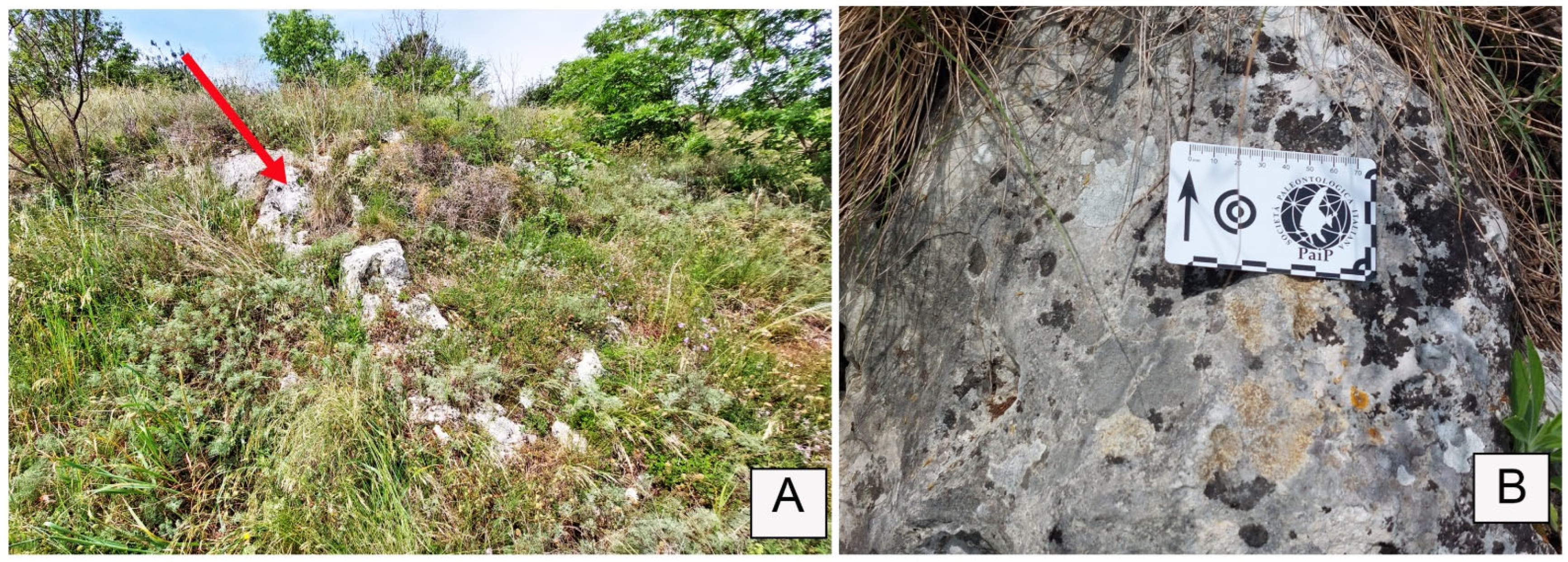
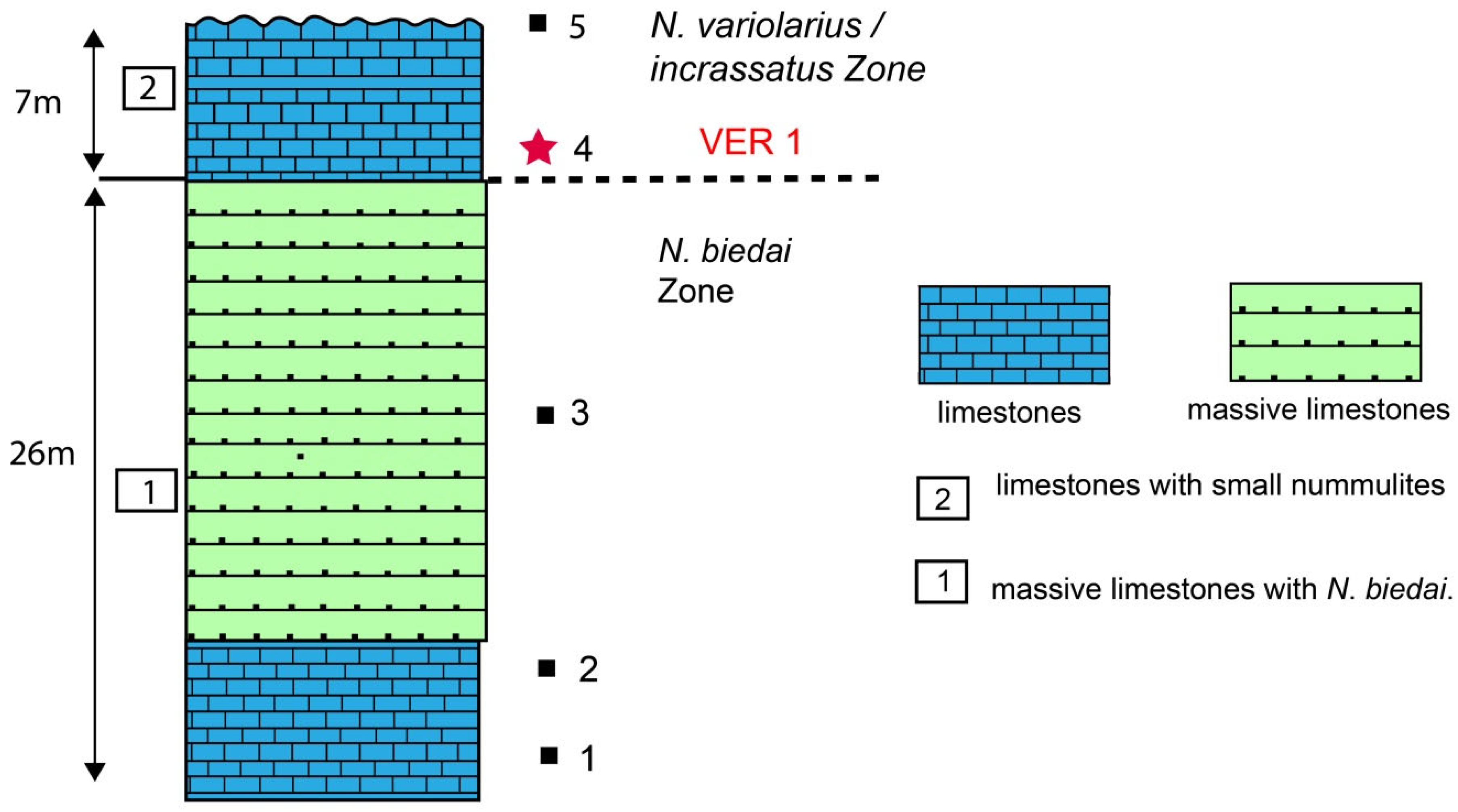
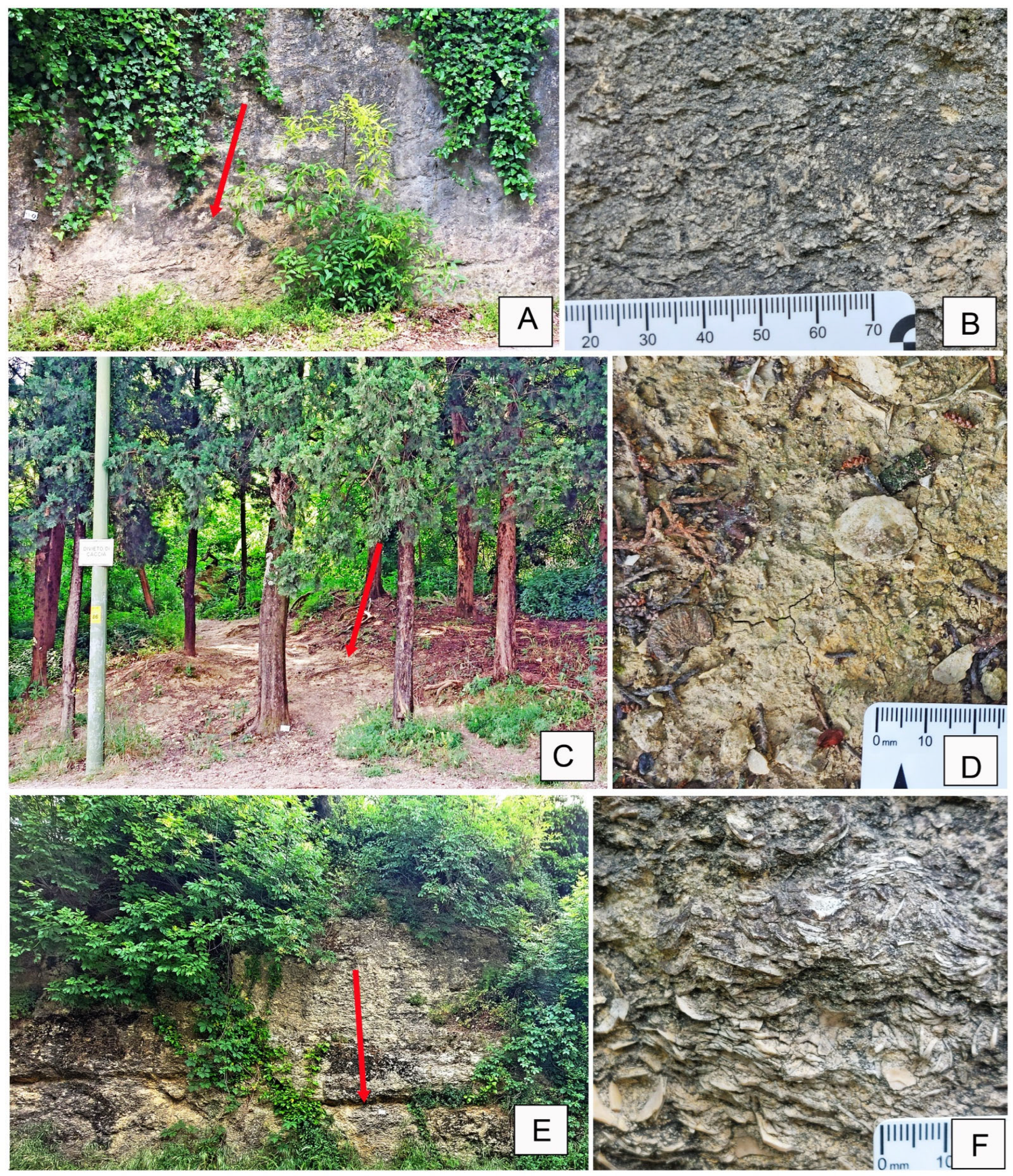
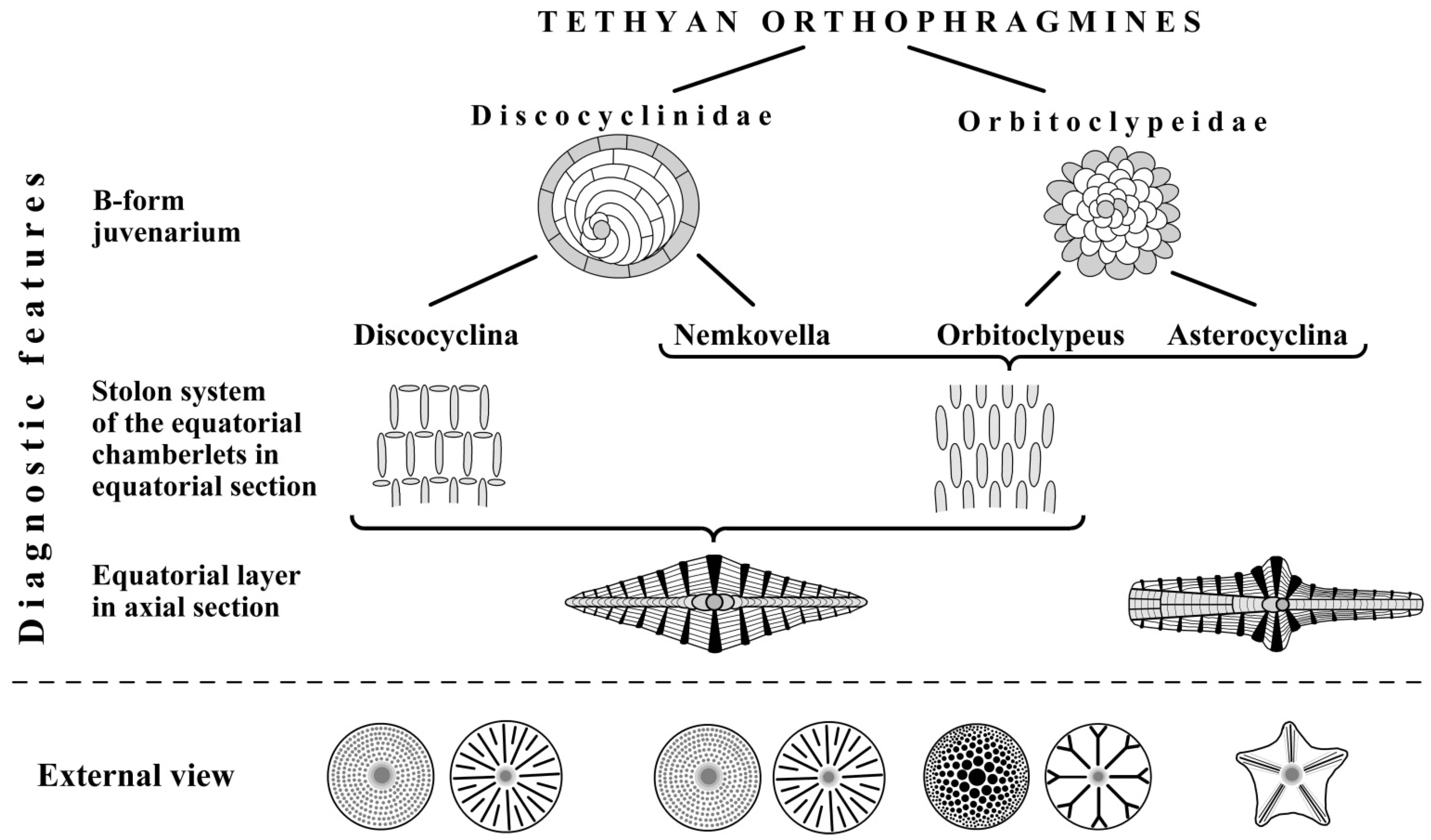
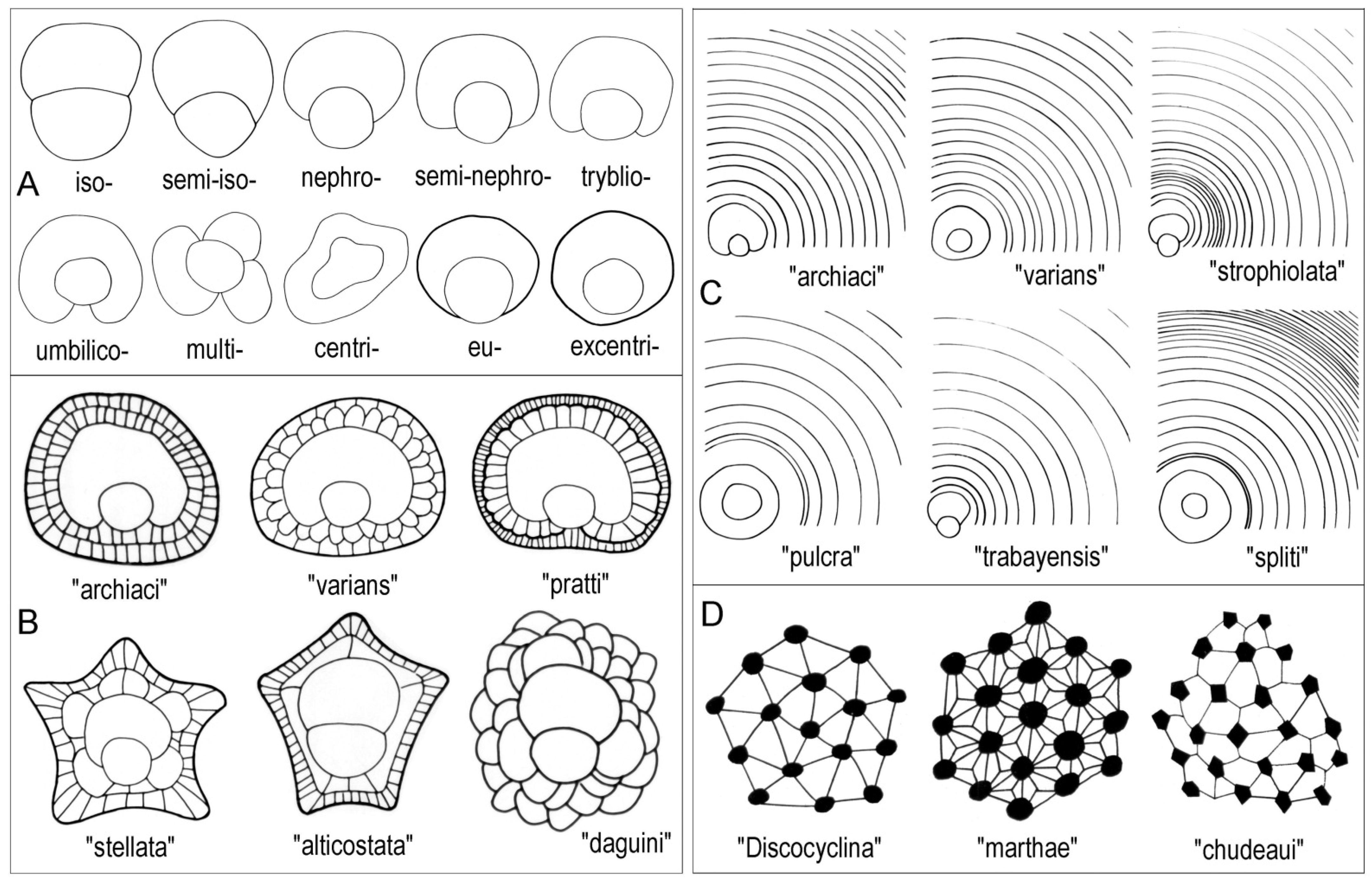
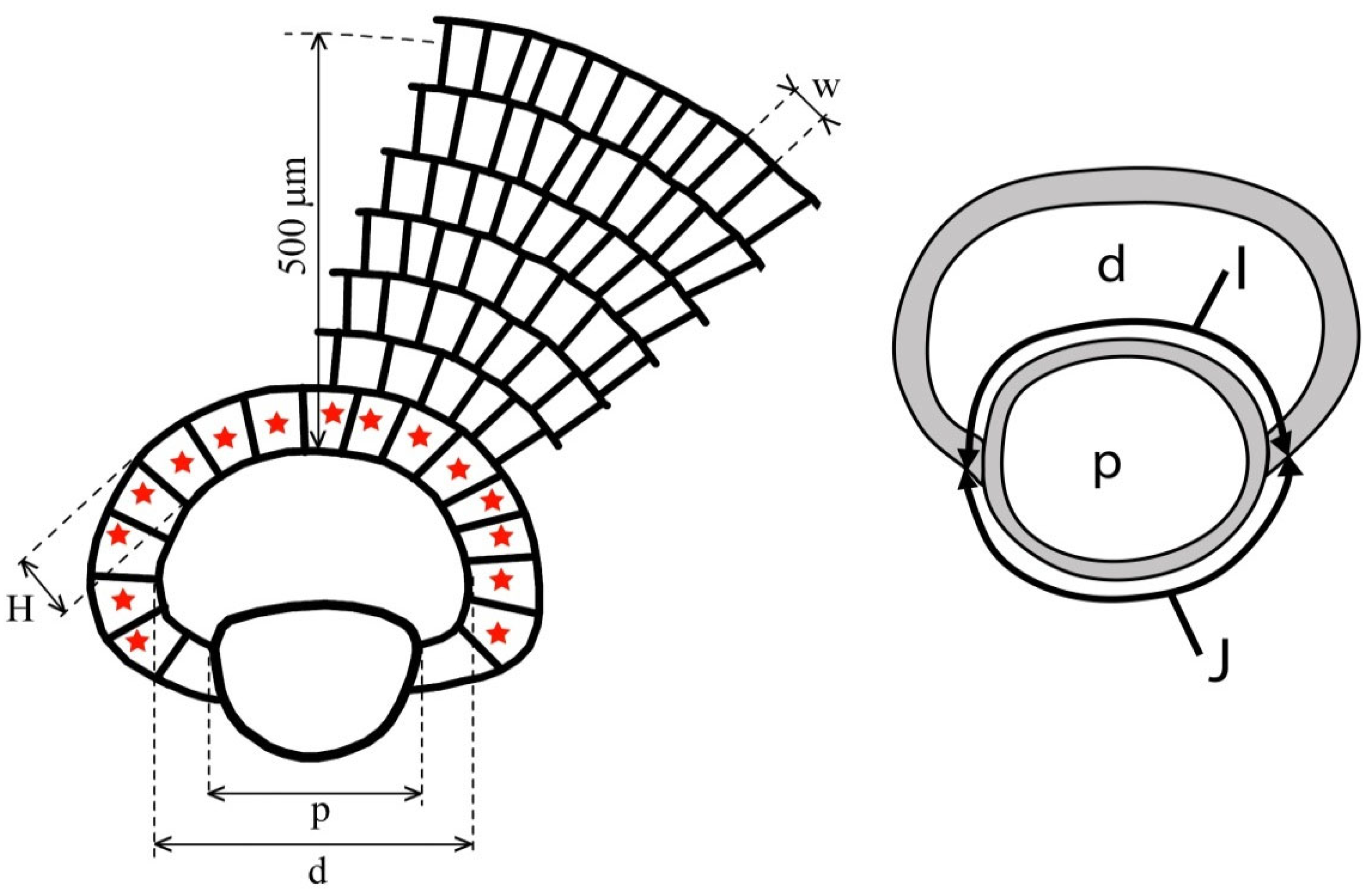
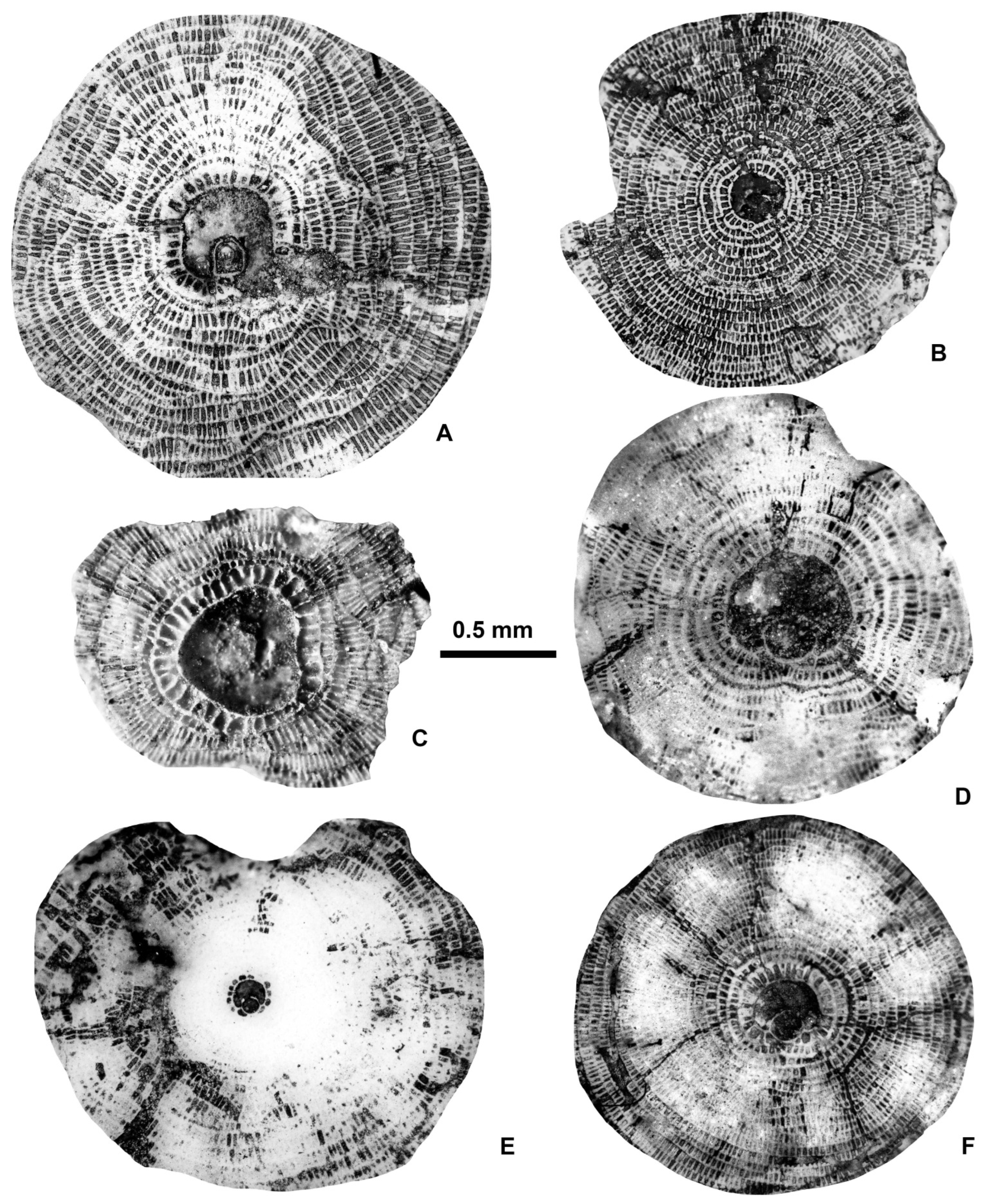
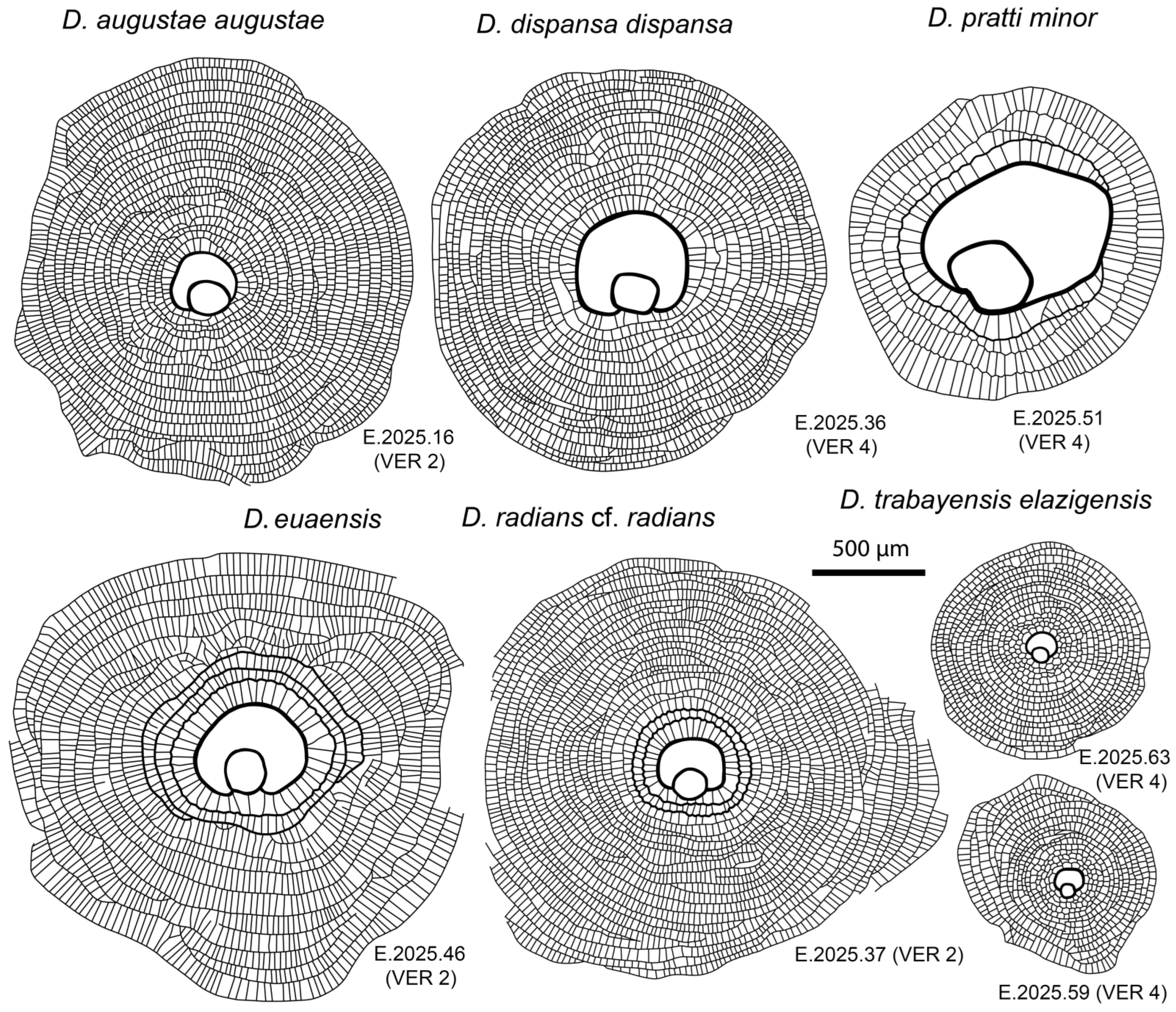
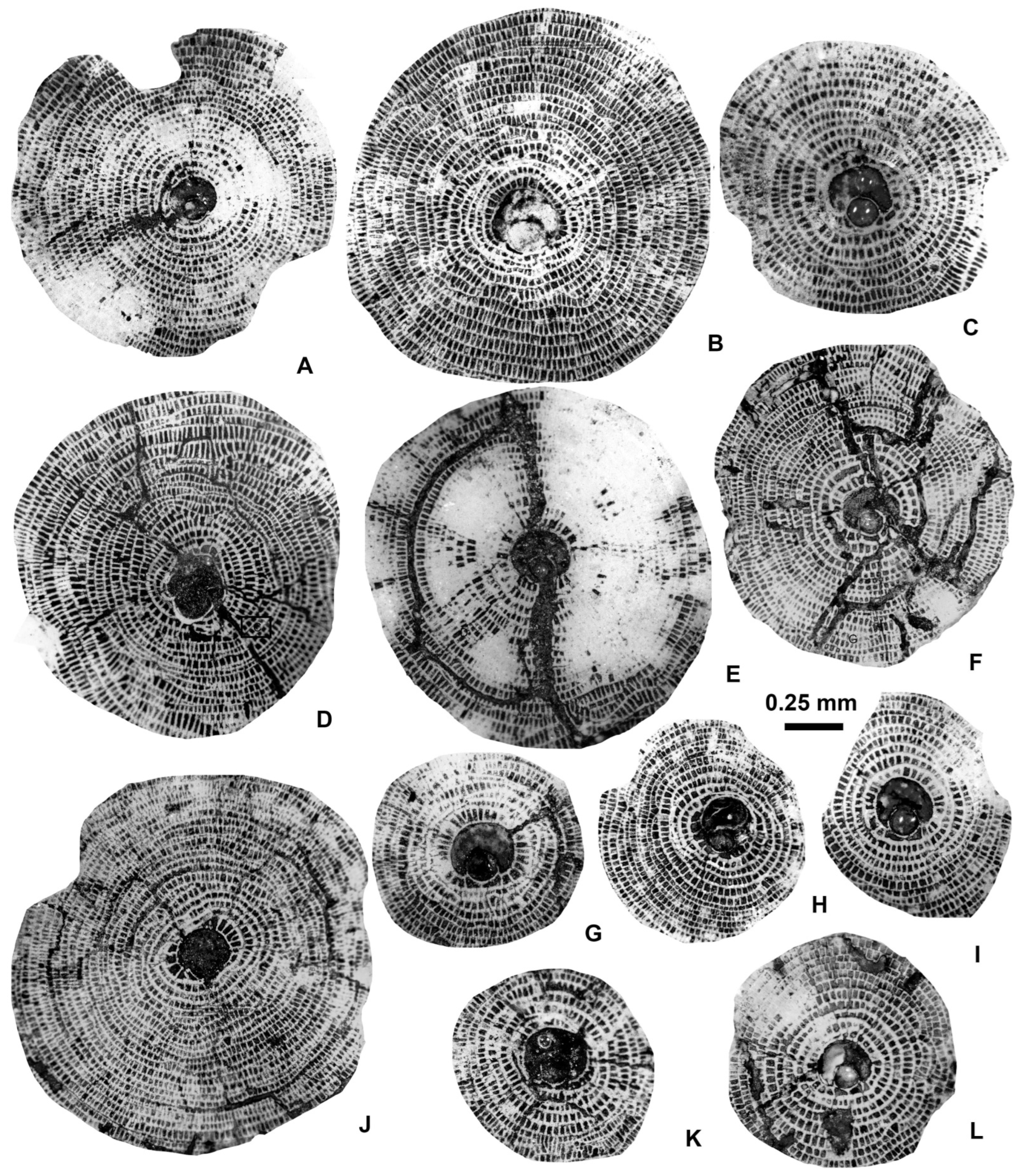

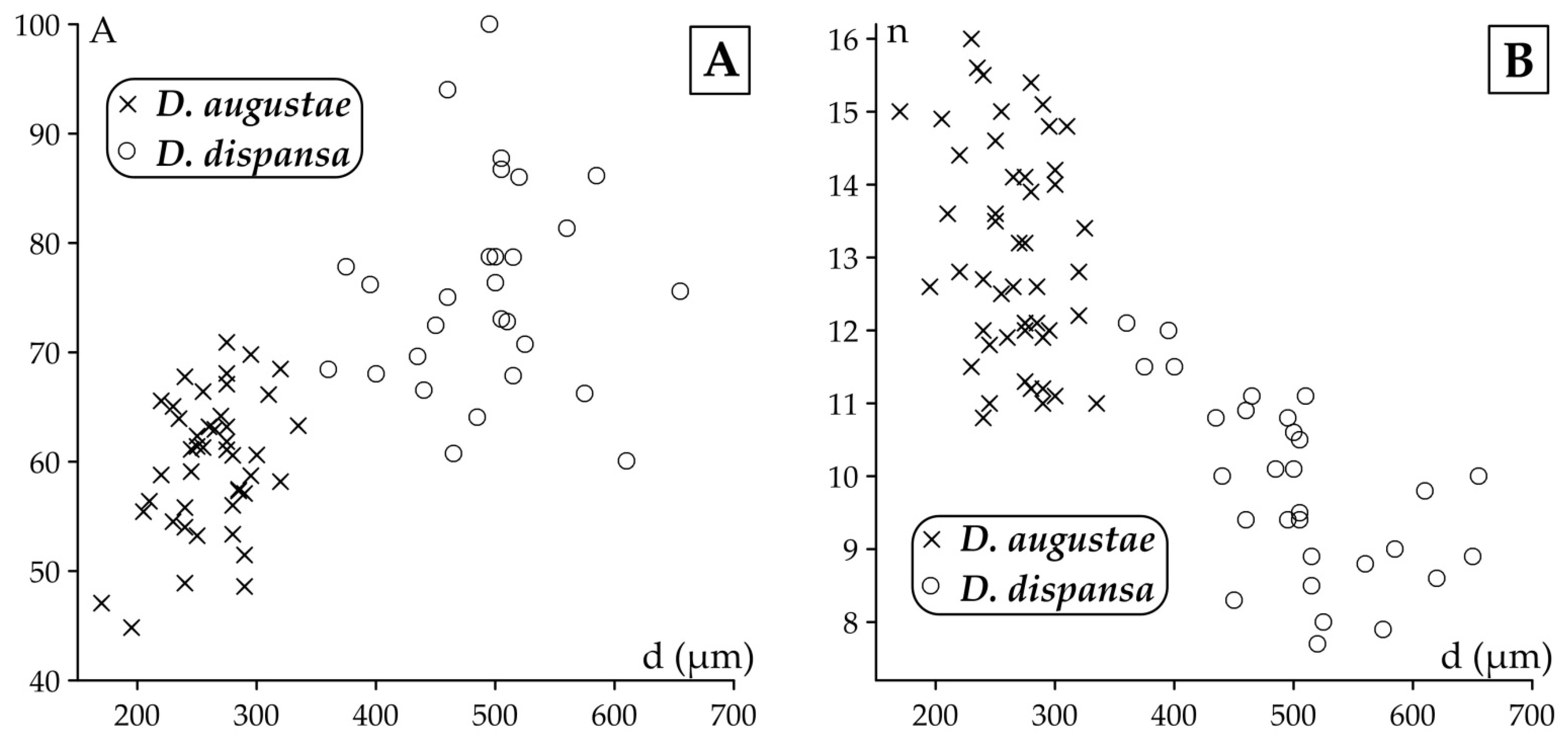

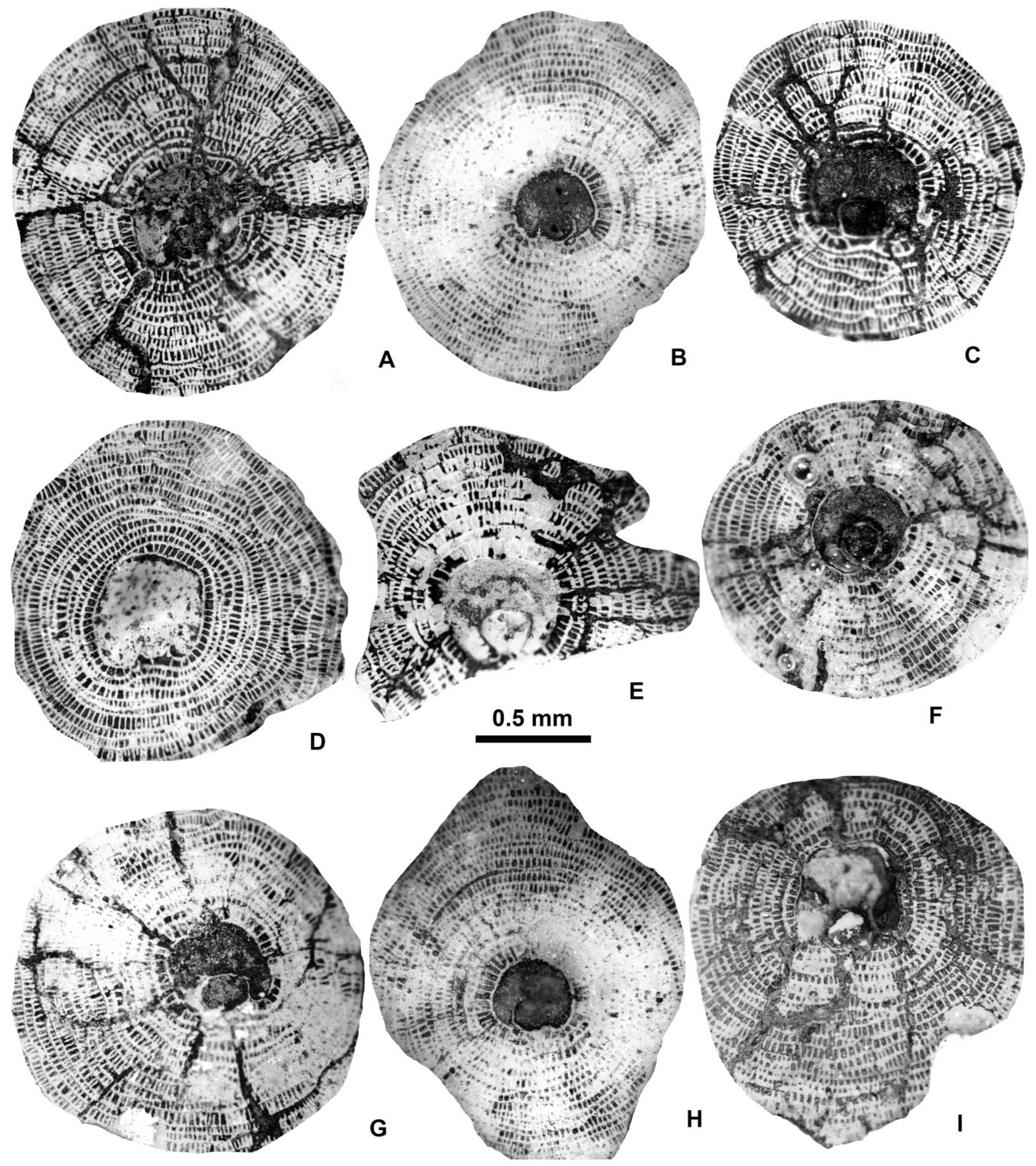
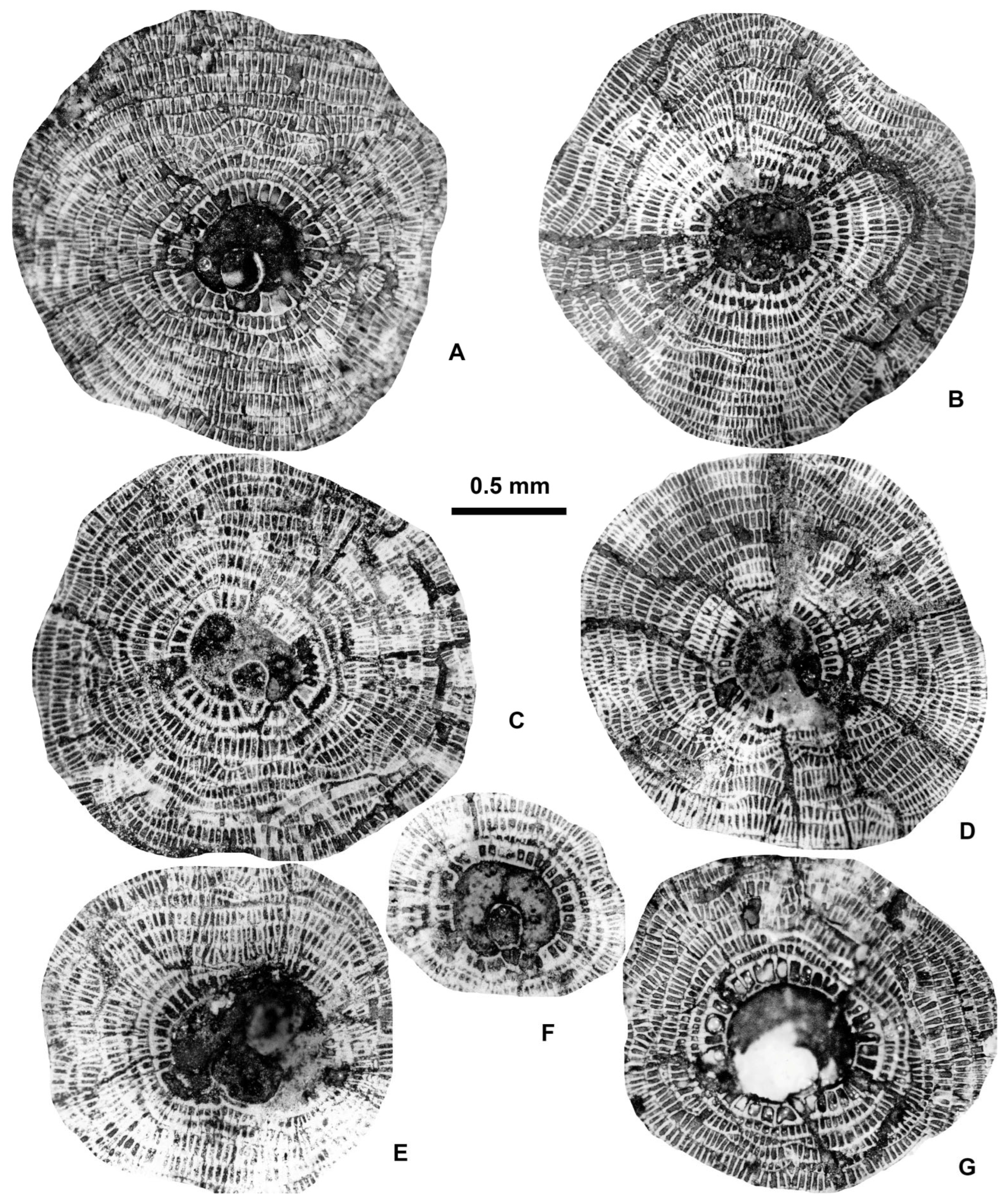


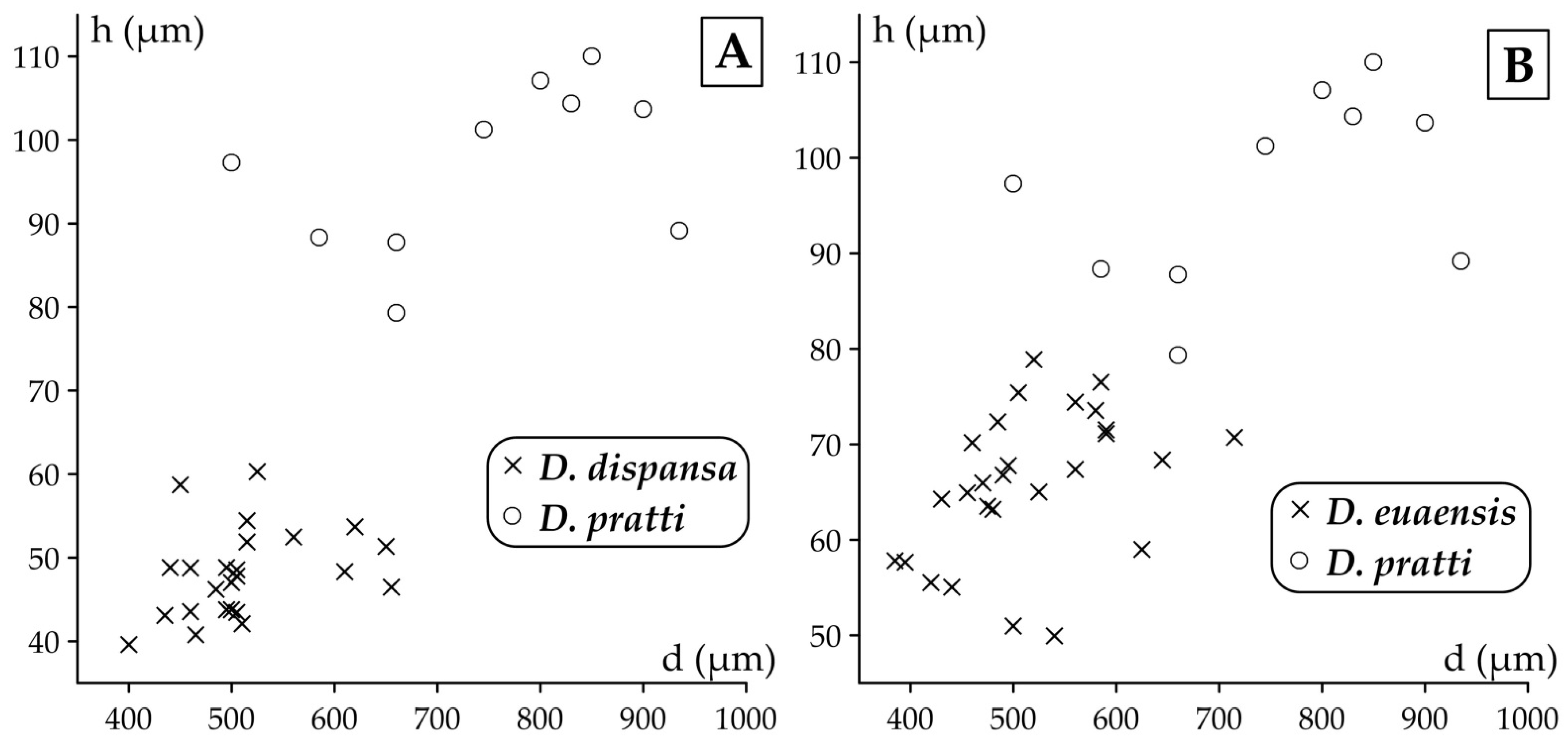
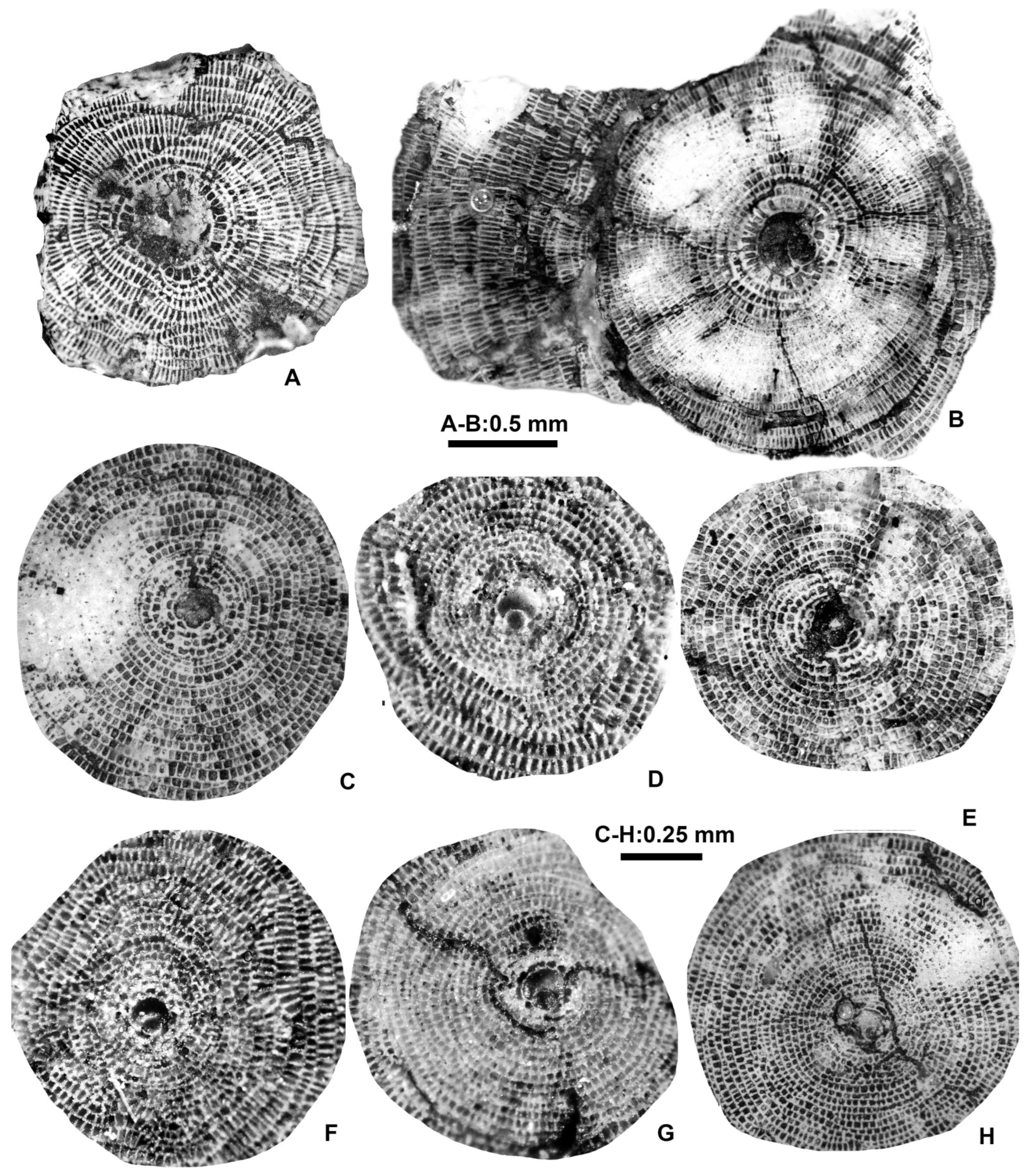
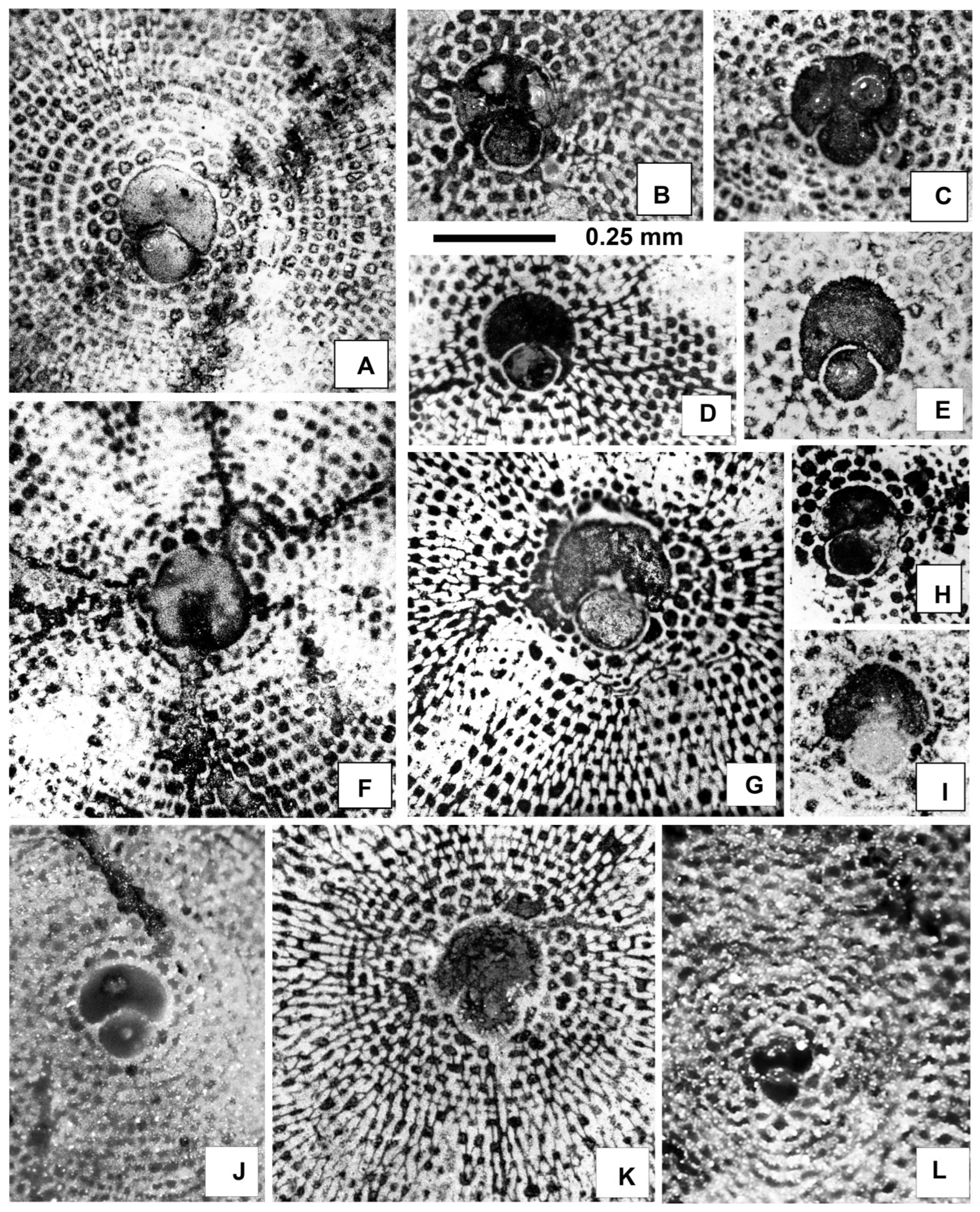
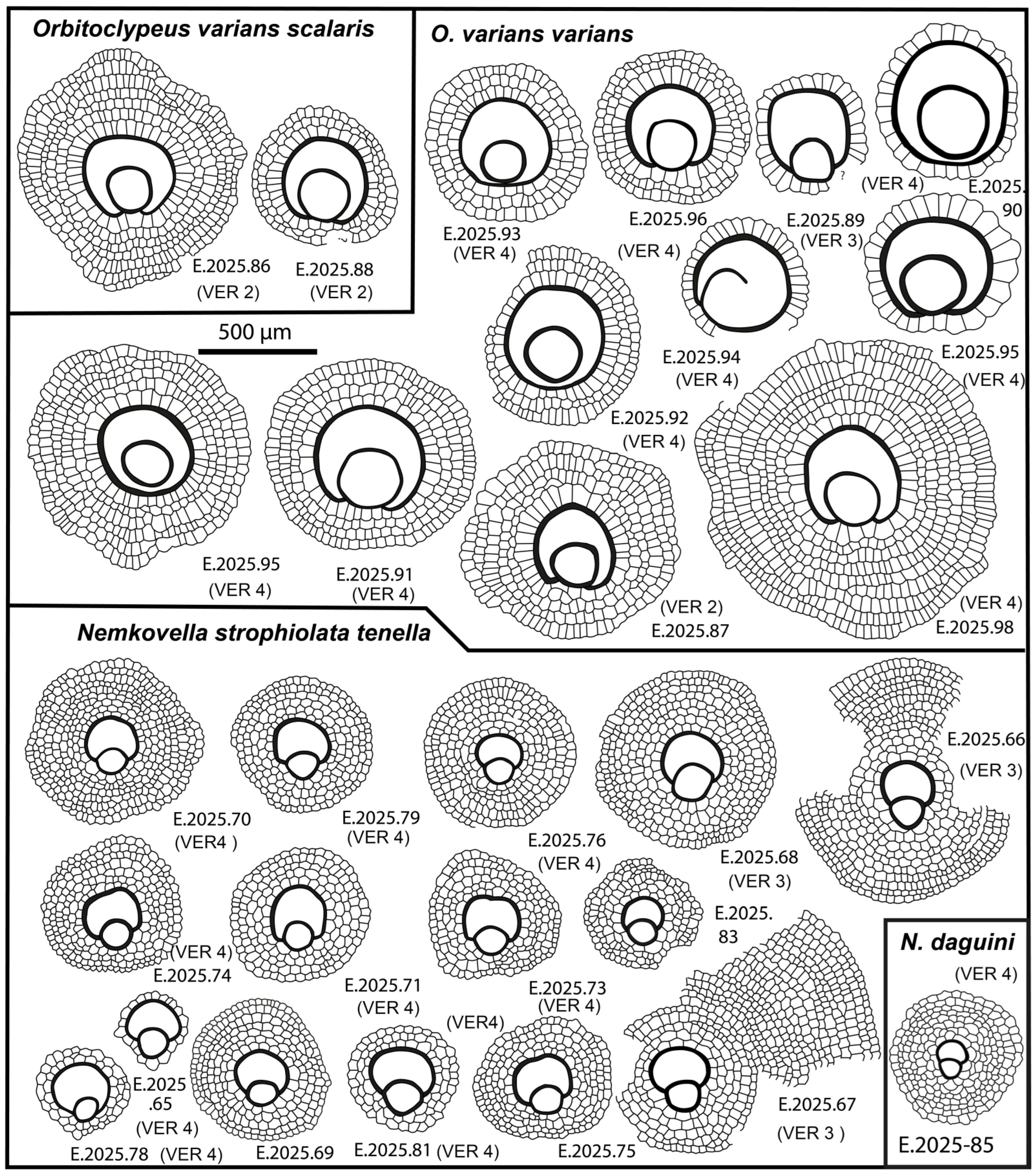
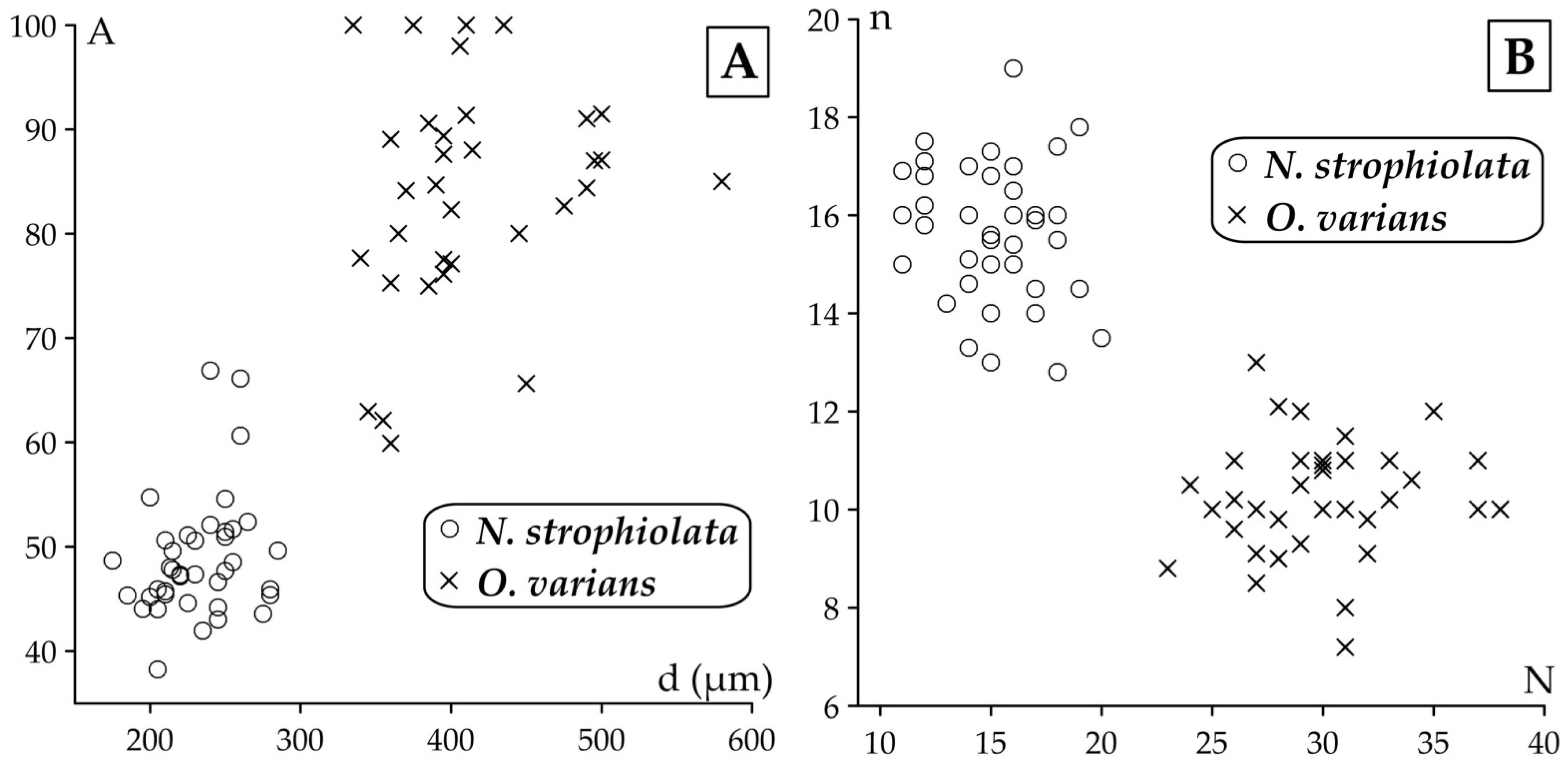
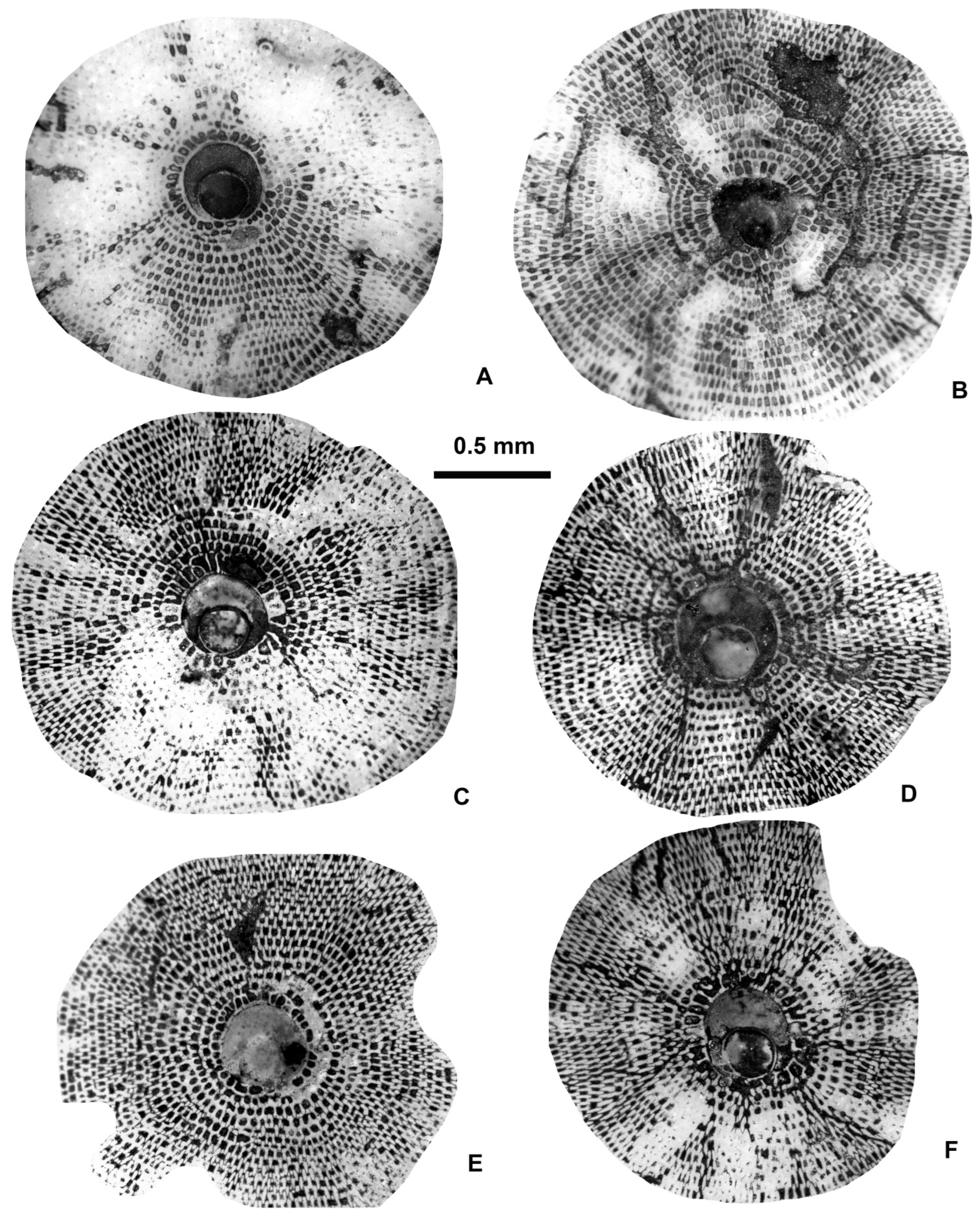
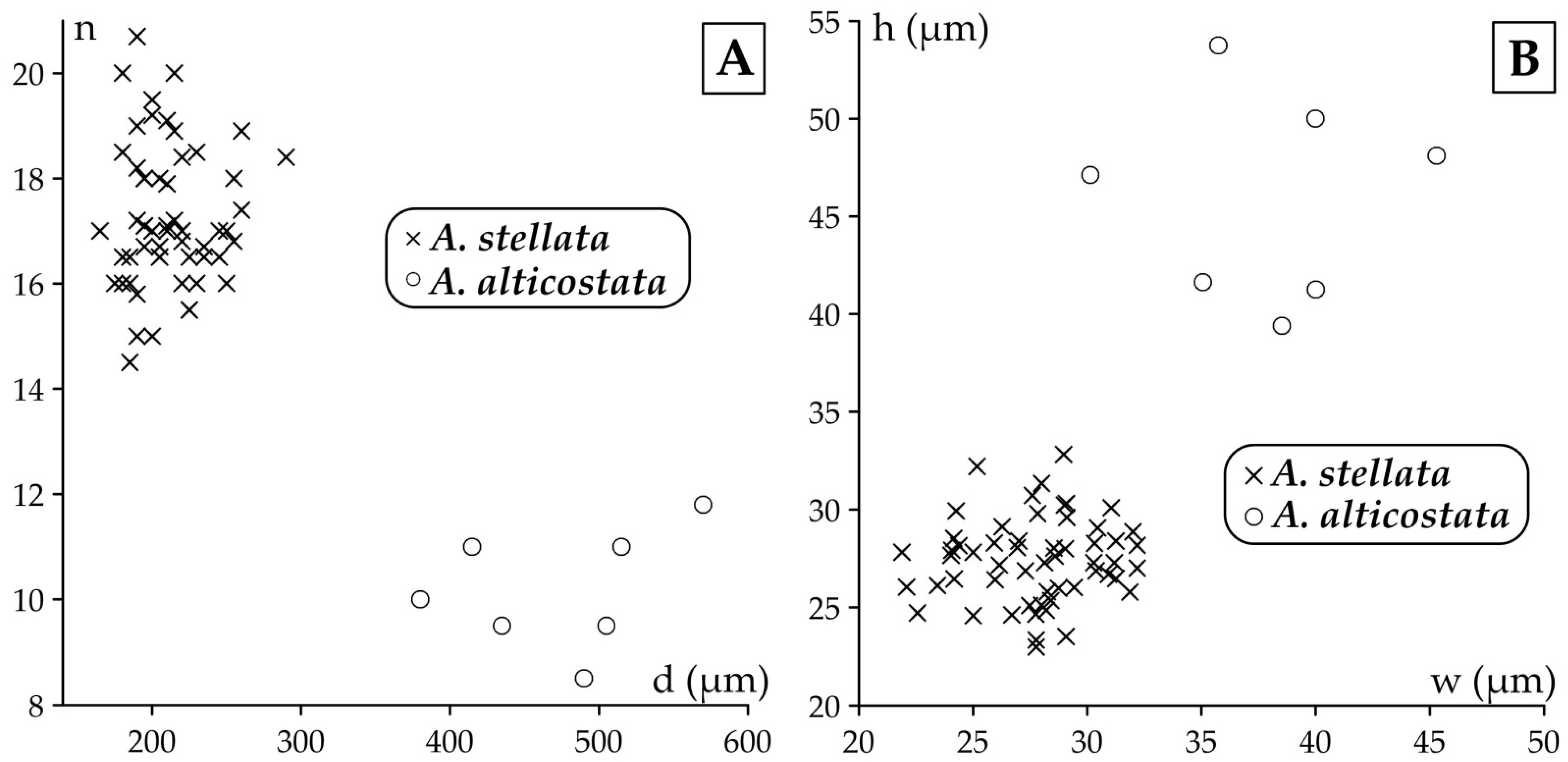
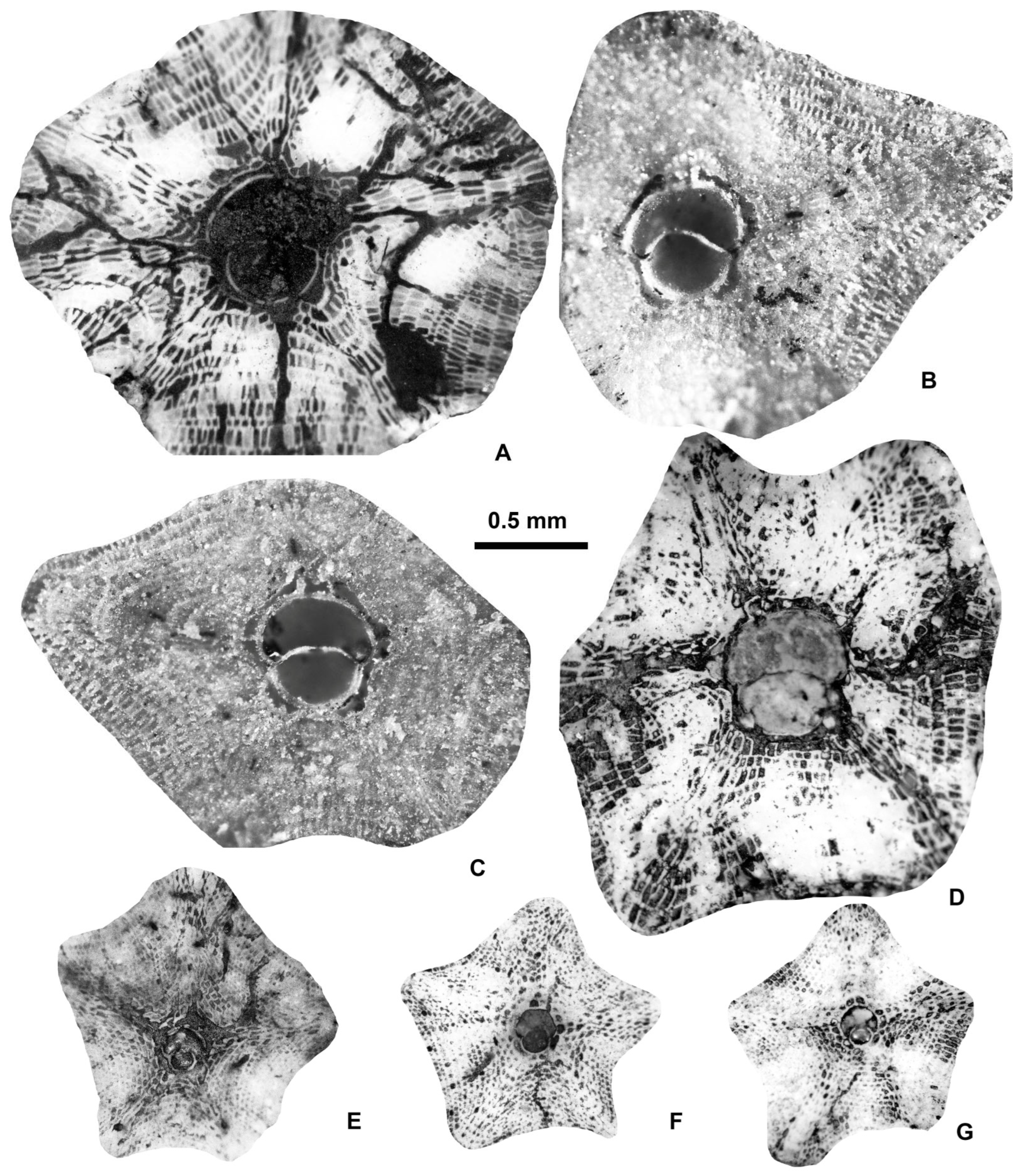
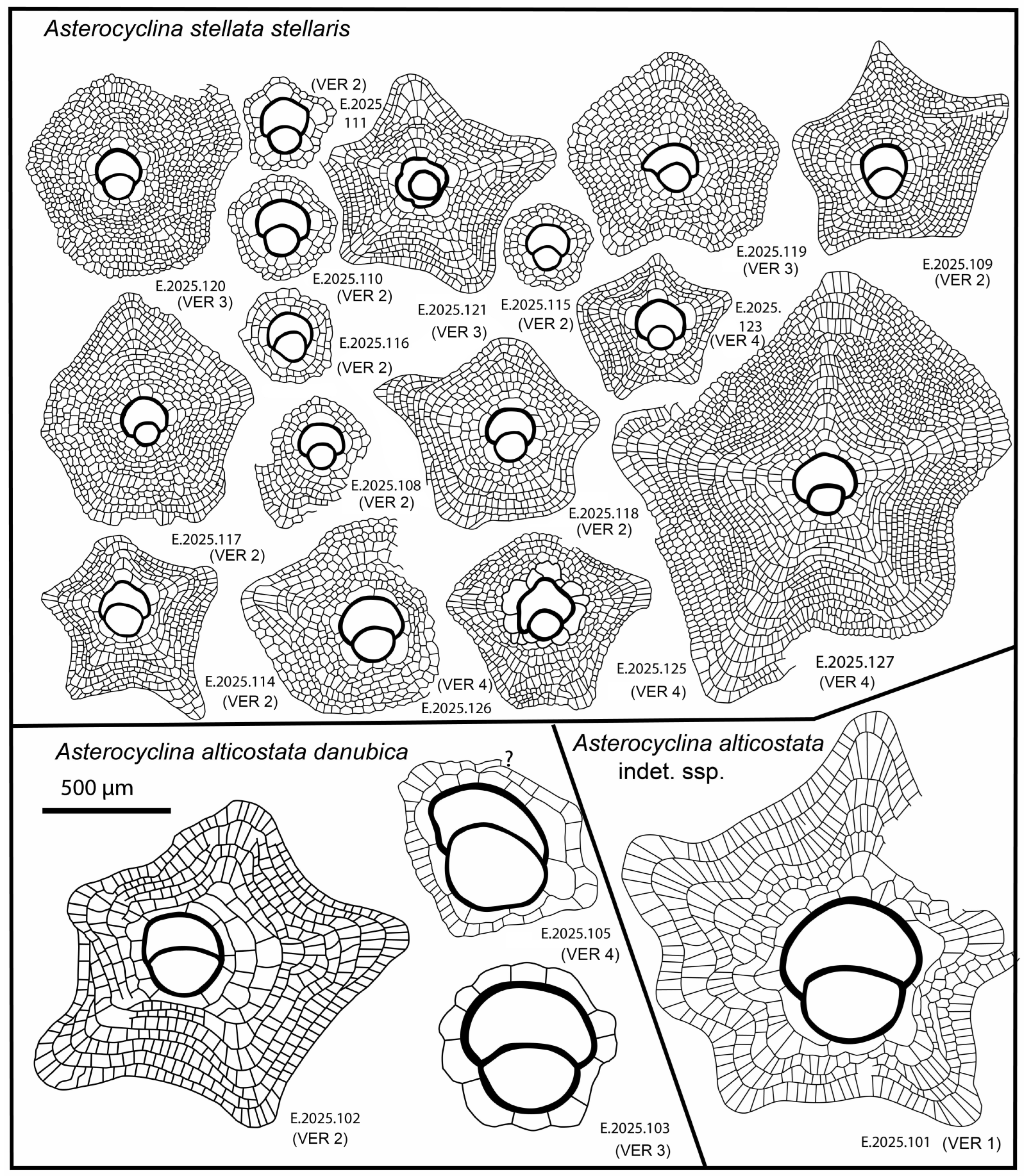
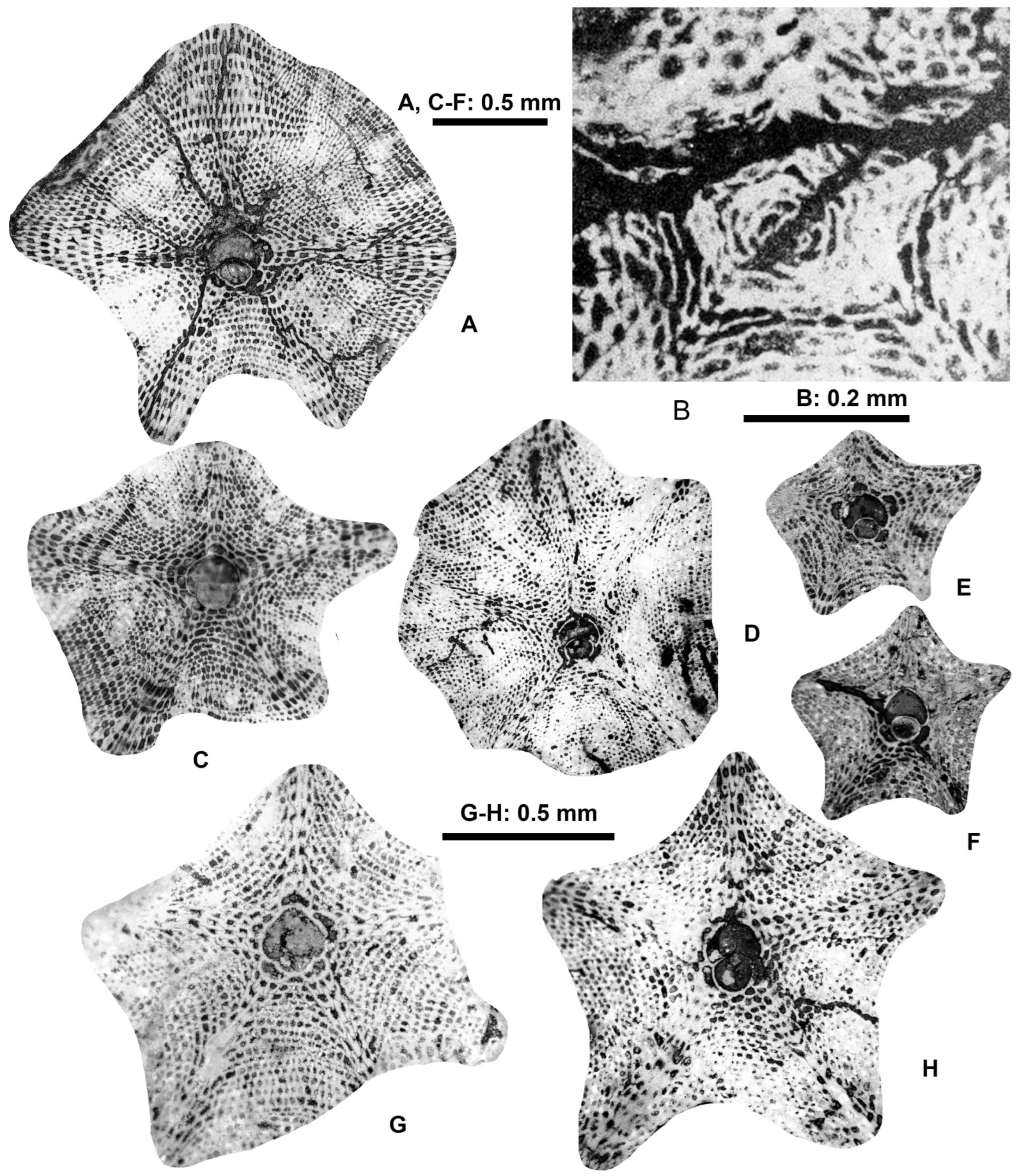
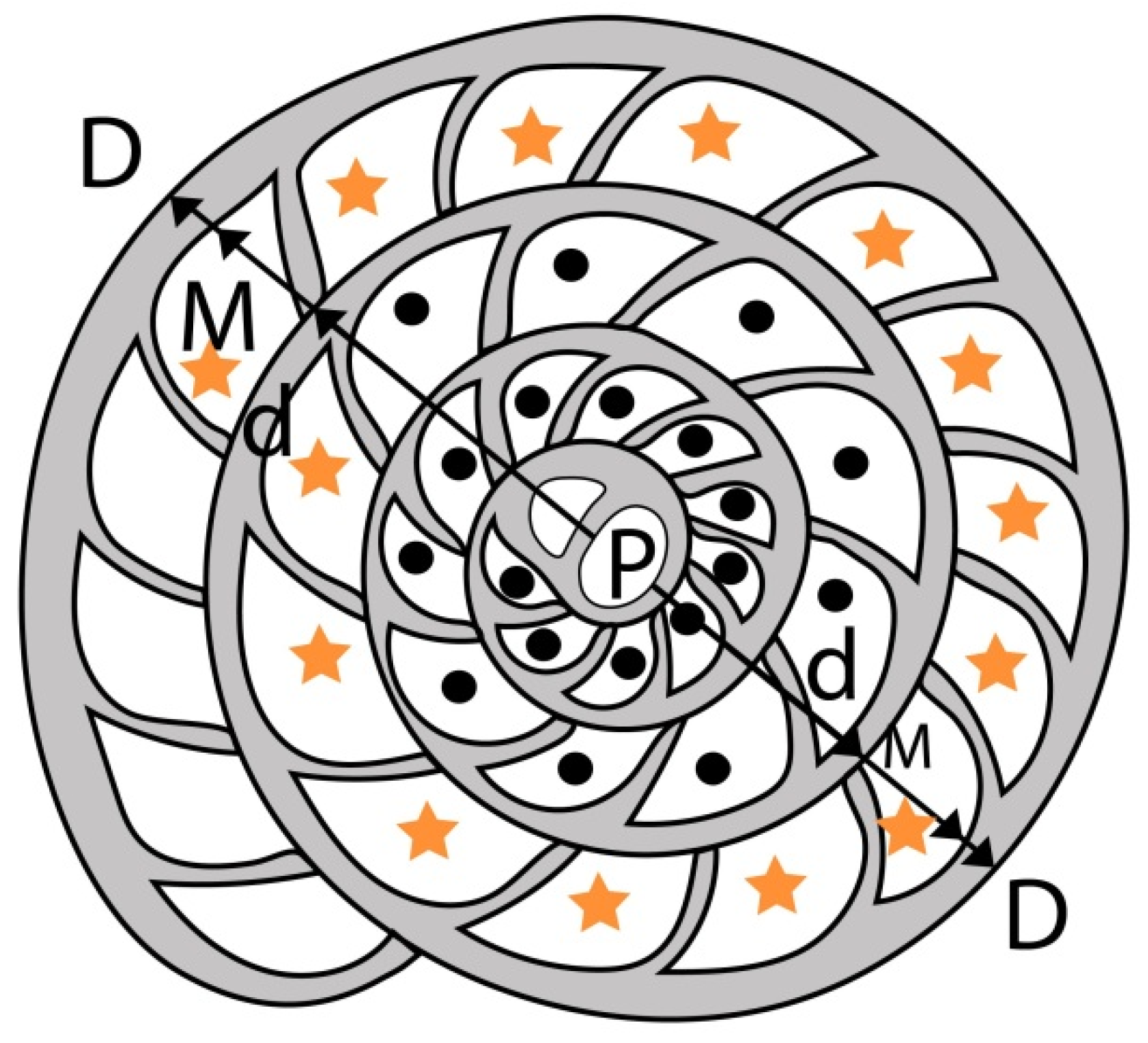
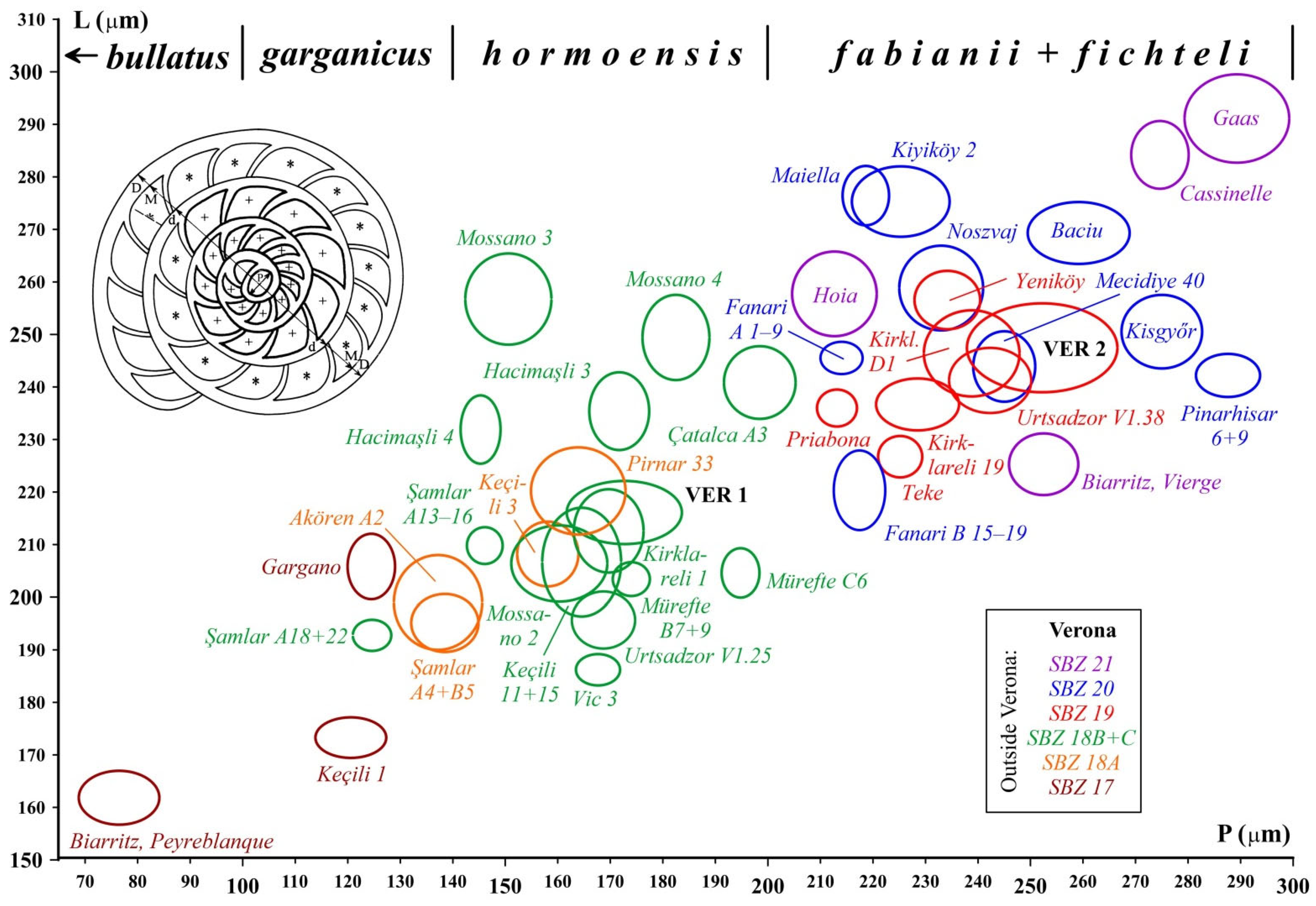
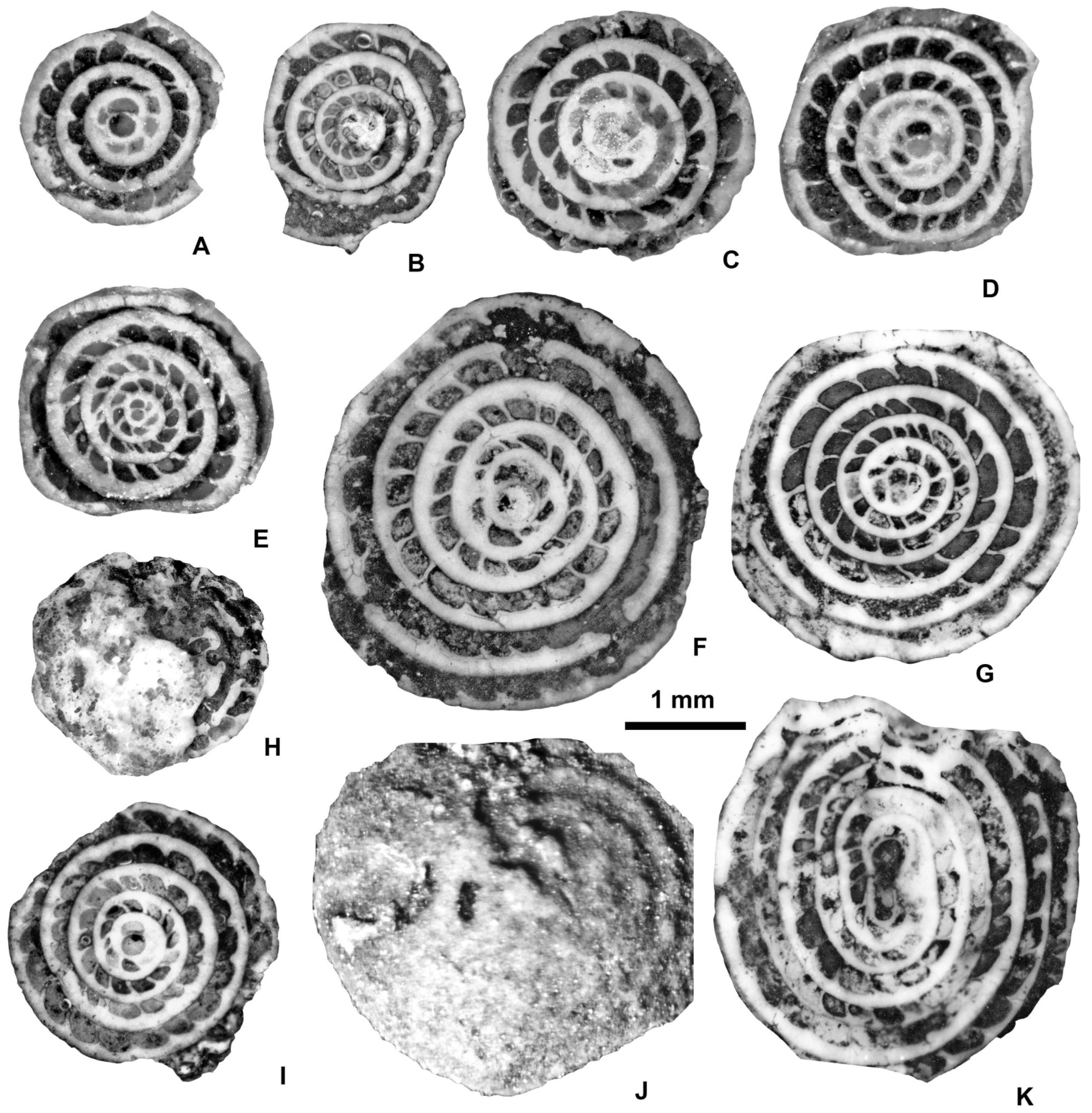
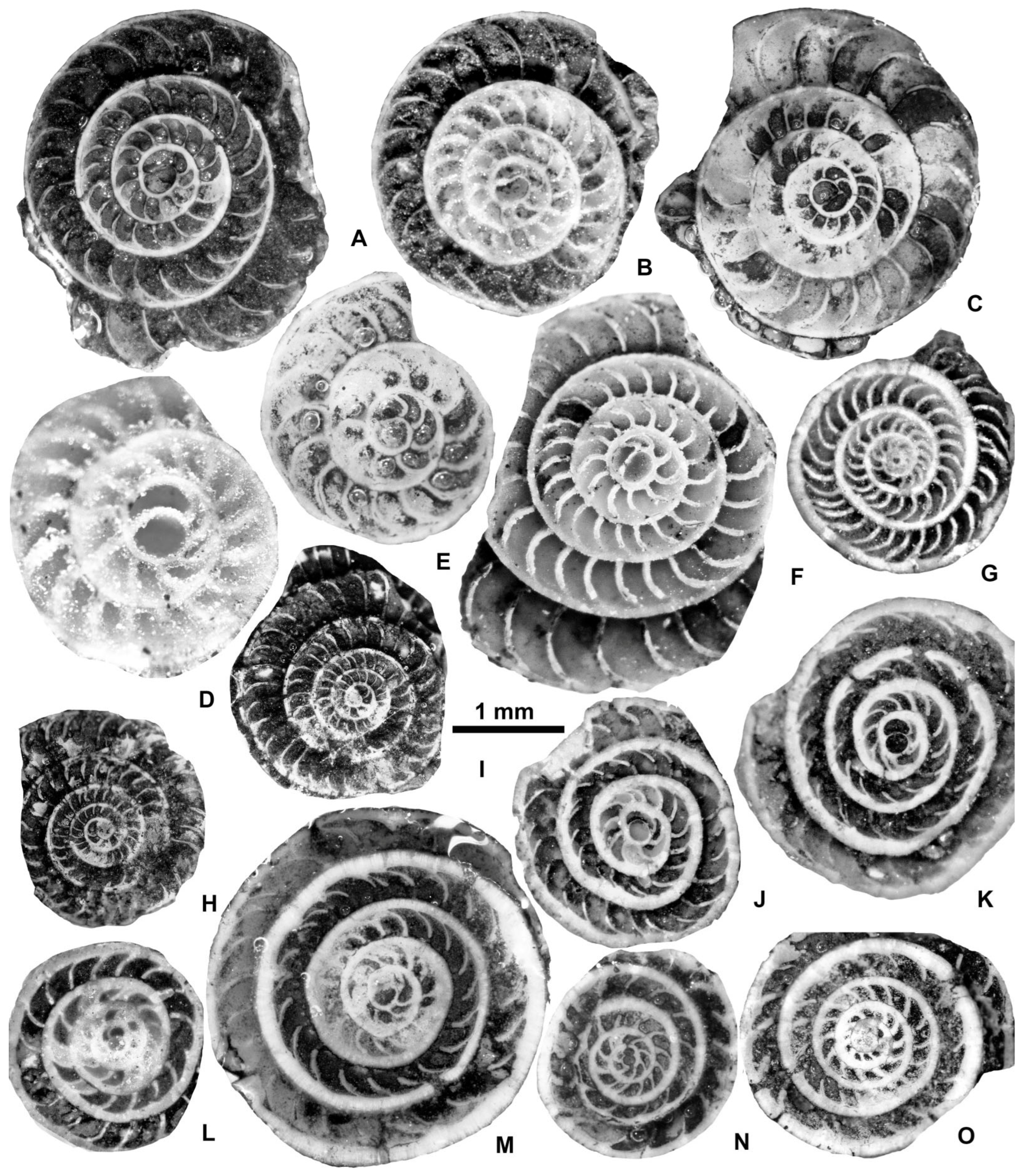
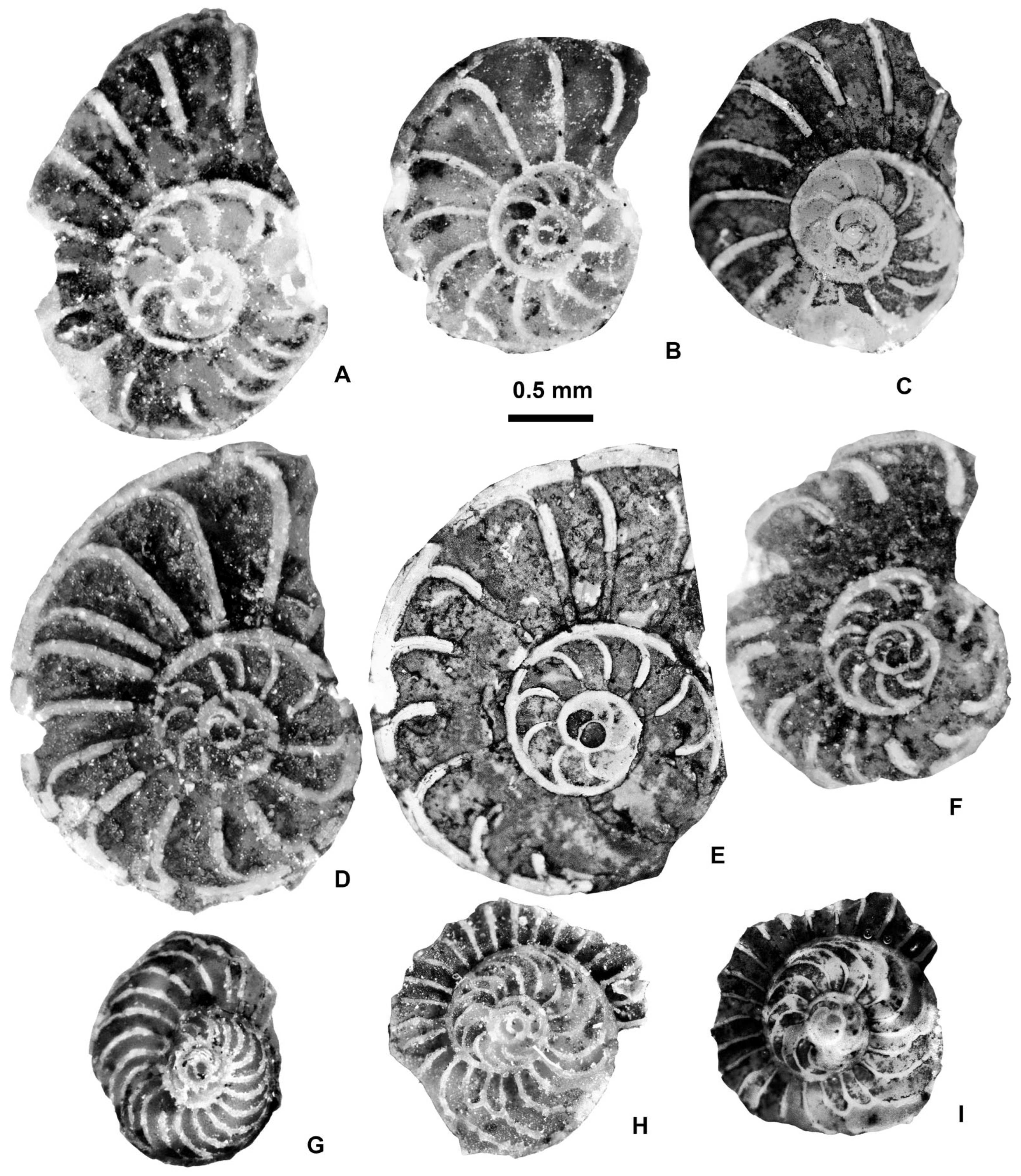
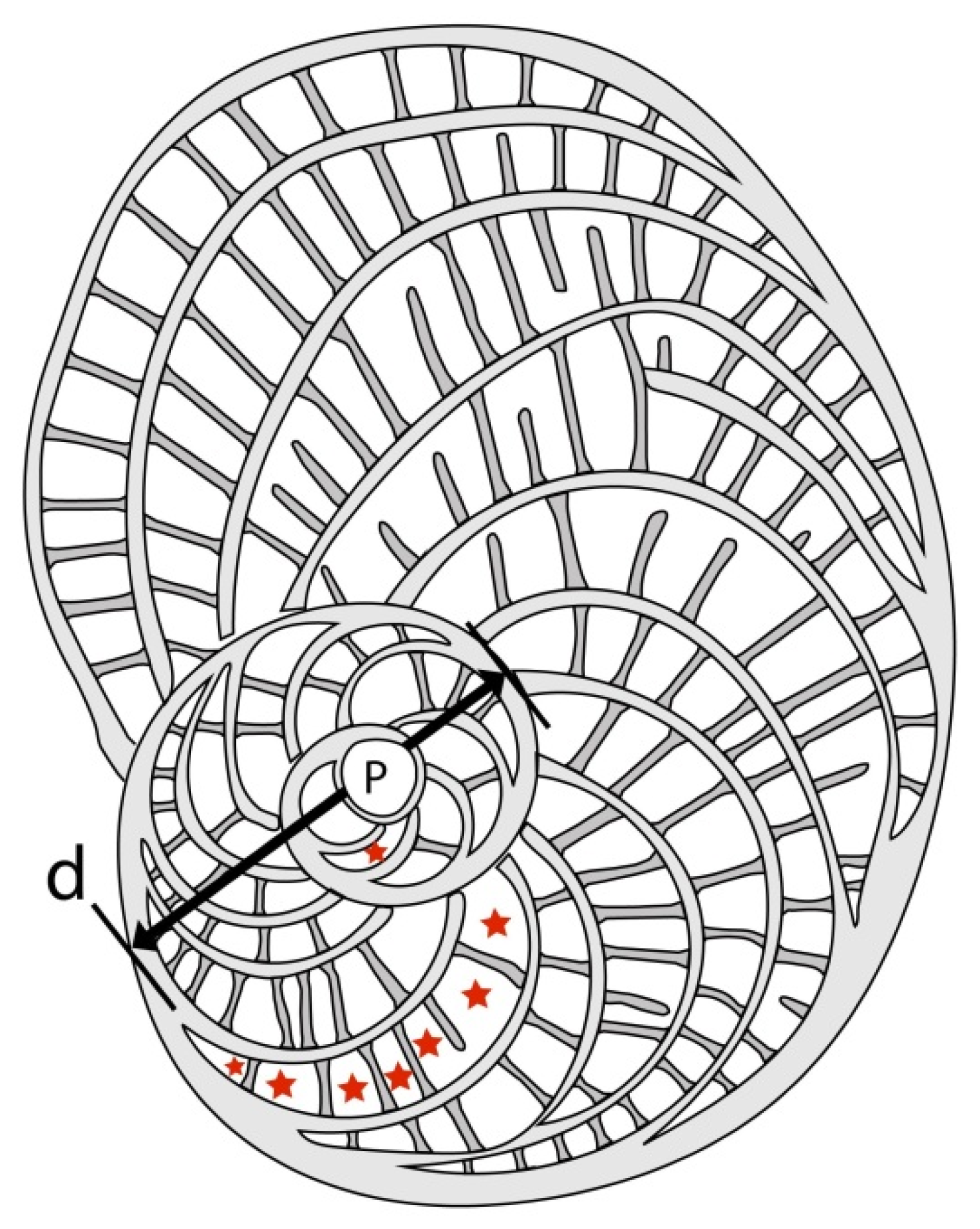
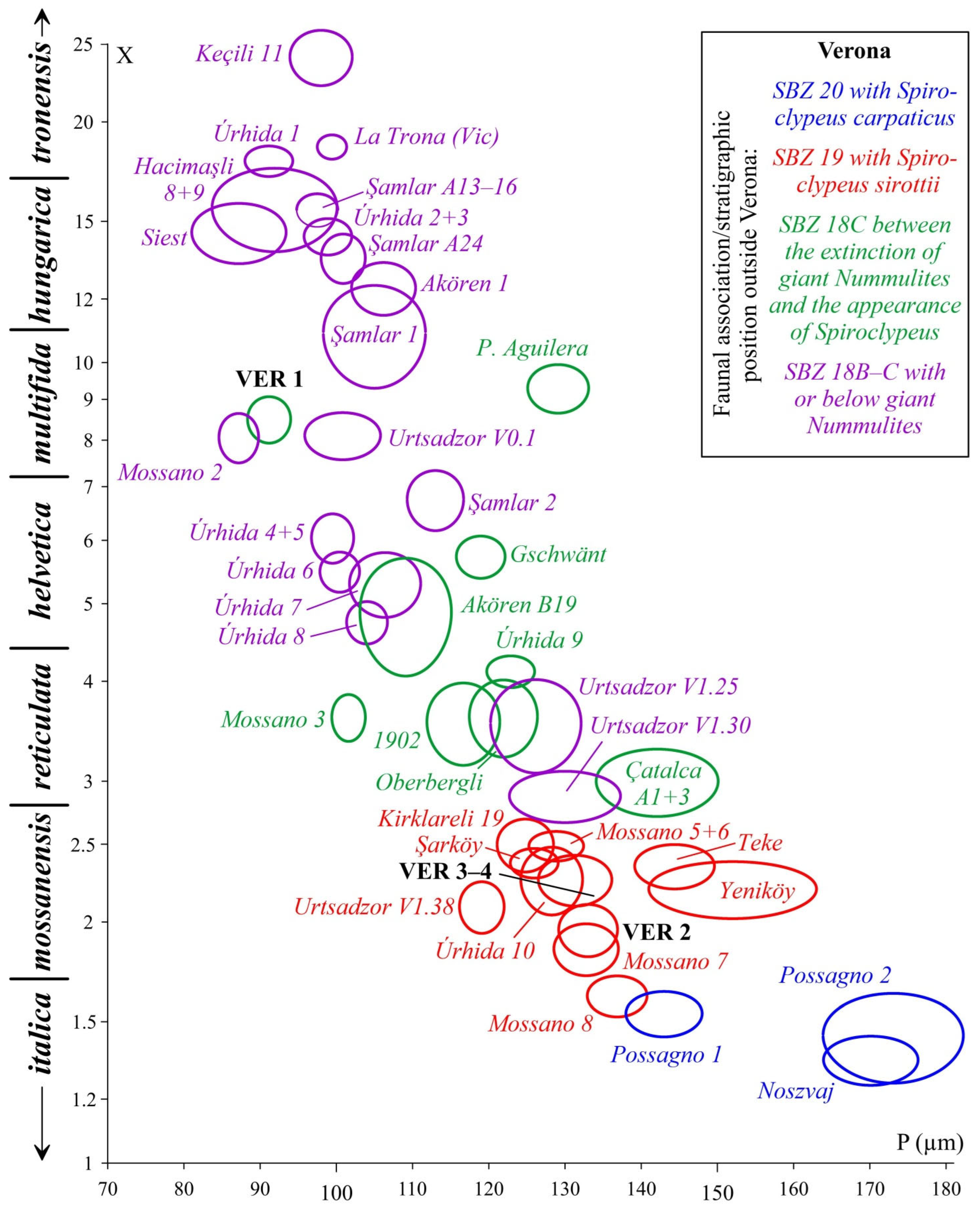
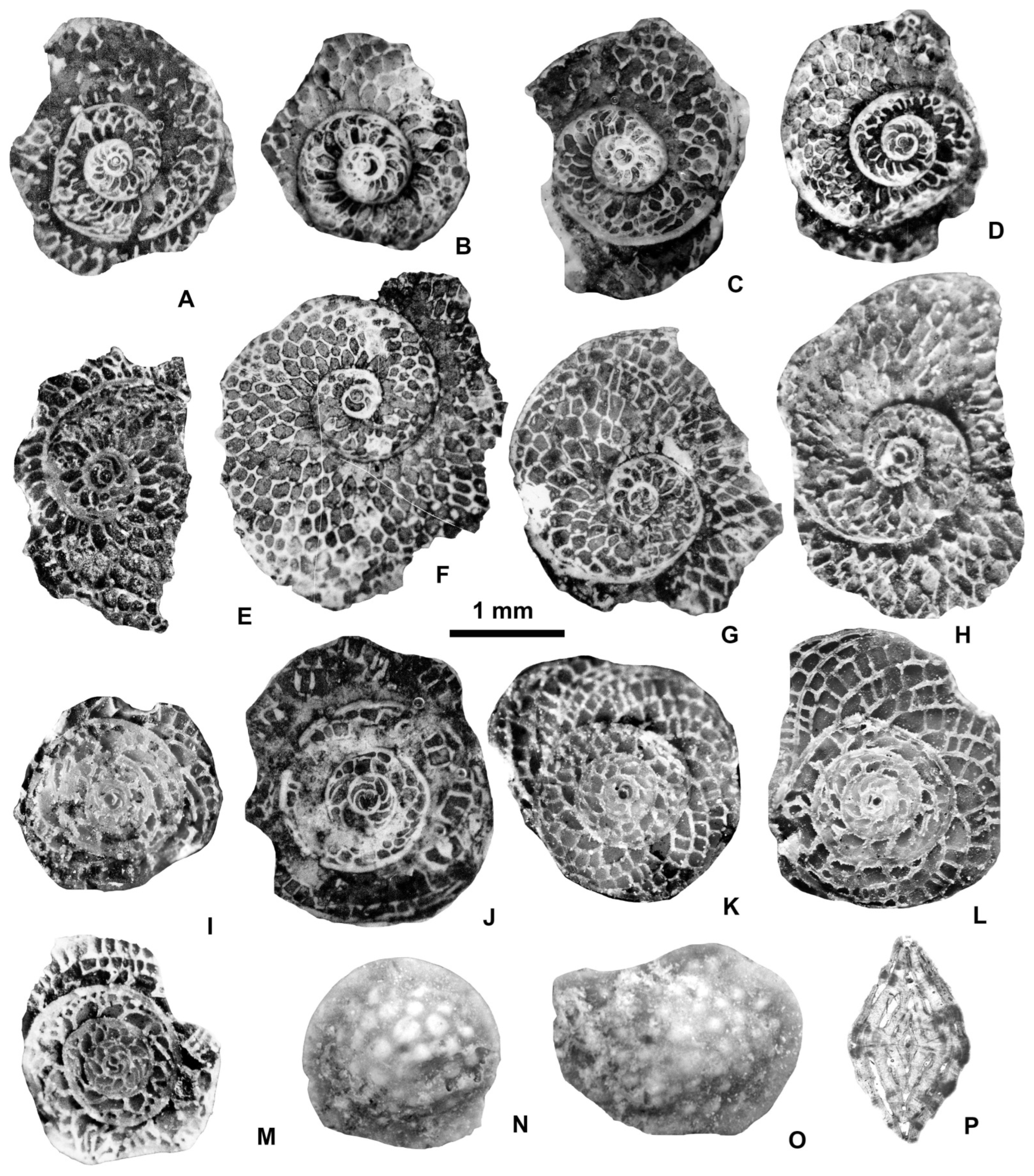
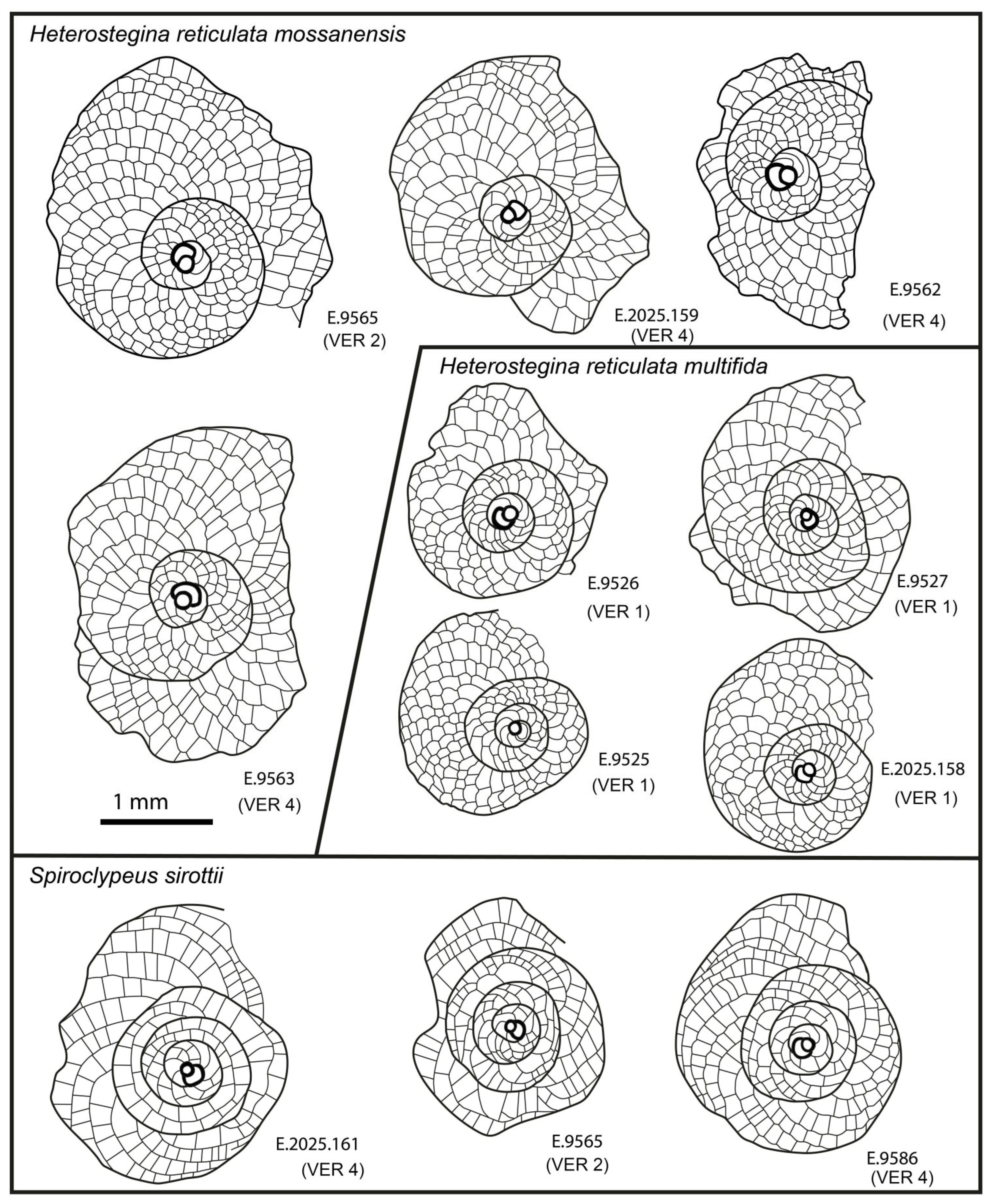

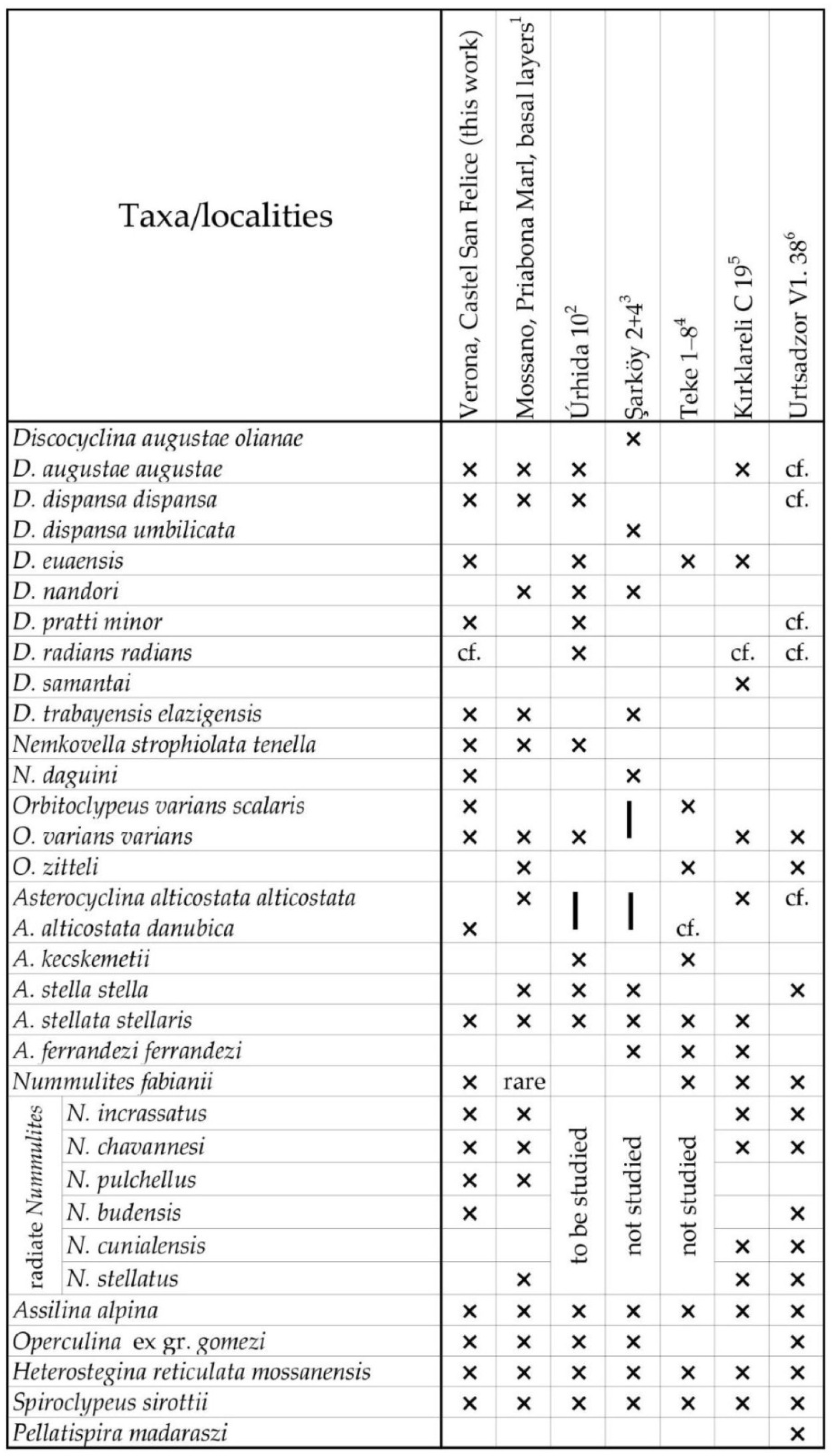
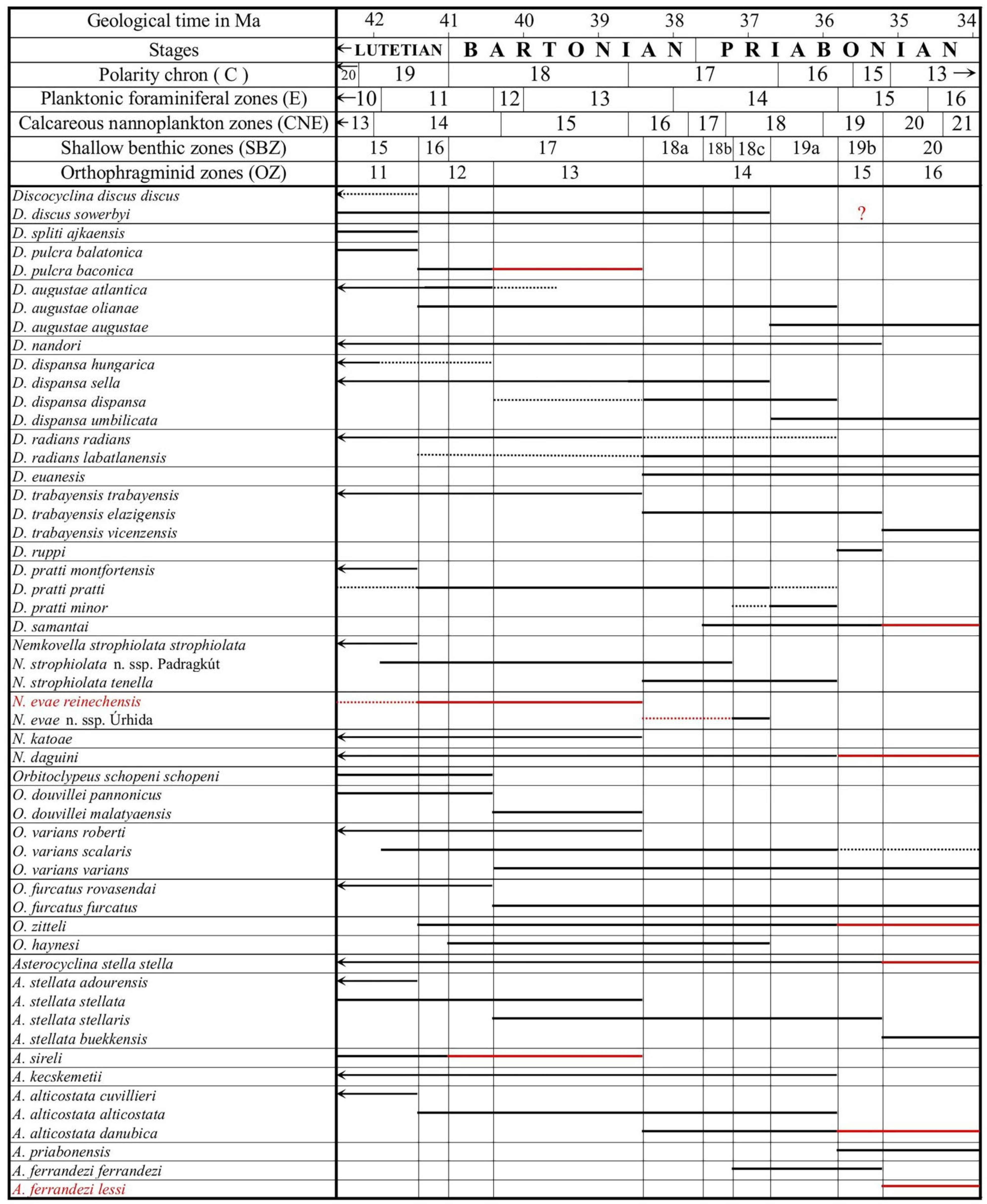
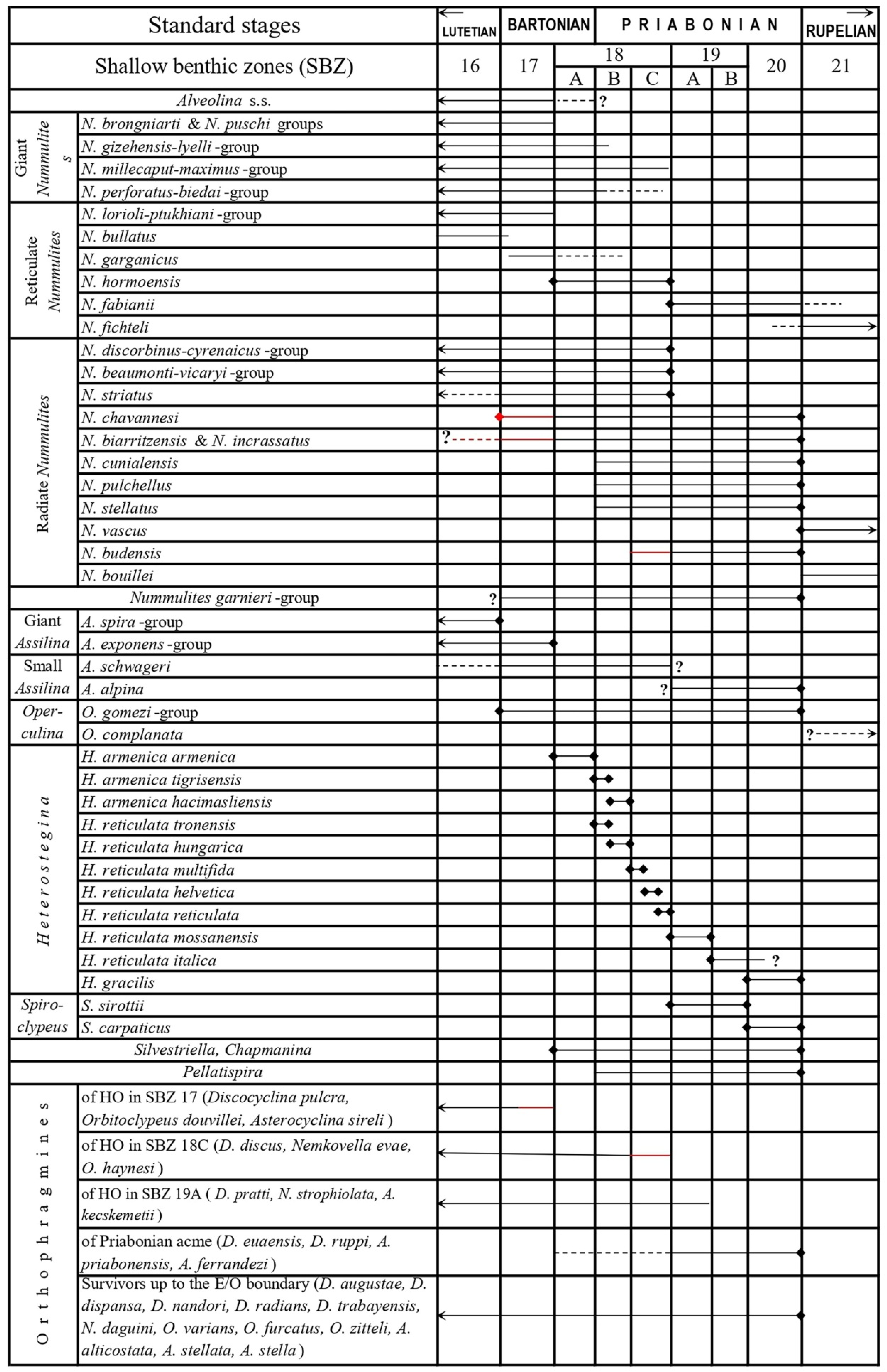
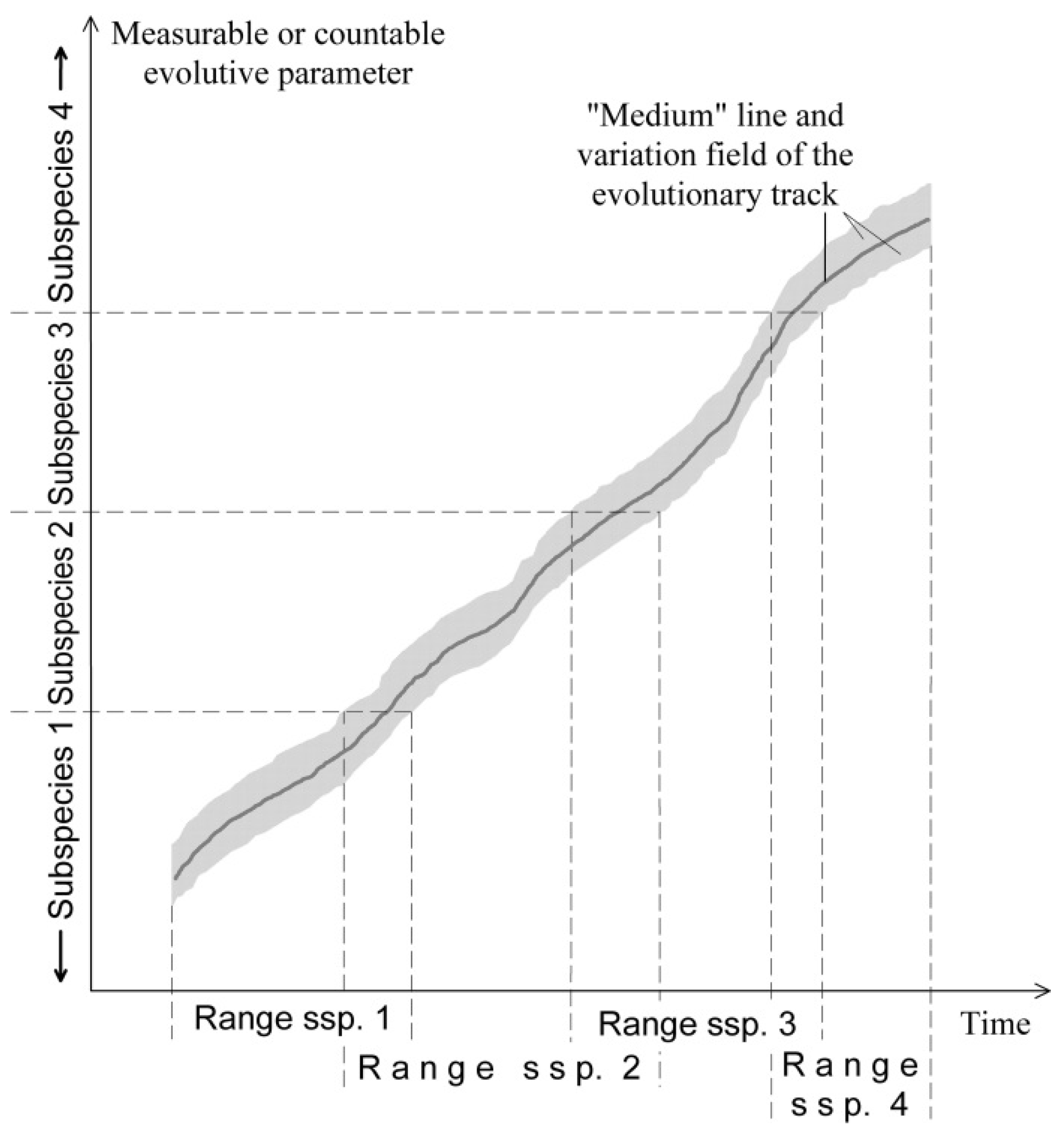
| Locality | Family | Discocyclinidae | Orbitoclypeidae | Nummulitidae | ||||||||||||||||||||||
|---|---|---|---|---|---|---|---|---|---|---|---|---|---|---|---|---|---|---|---|---|---|---|---|---|---|---|
| Sample/Taxon | Disocyclina augustae augustae | D. dispansa dispansa | D. euaensis | D. pratti minor | D. radians cf. radians | D. trabayensis elazigensis | Nemkovella strophiolata tenella | N. daguini | Orbitoclypeus varians scalaris | O. varians varians | Asterocyclina alticostata indet. ssp. | A. alticostata danubica | A. stellata cf. stellaris | A. stellata stellaris | Nummulites hormoensis | N. fabianii | N. chavannesi | N. incrassatus | N. budensis | N. pulchellus | Assilina alpina | Operculina ex gr. gomezi | Heterostegina reticulata multifida | H. reticulata mossanensis | Spiroclypeus sirottii | |
| Monte Cavro | VER 1 | × | × | + | + | × | + | |||||||||||||||||||
| Caster San Felice | VER 2 | + | + | × | + | × | × | + | + | + | + | × | × | + | + | |||||||||||
| VER 3 | + | + | × | + | × | × | + | × | × | + | × | + | + | |||||||||||||
| VER 4 | + | + | + | × | + | + | × | + | × | + | × | × | + | × | + | + | ||||||||||
| Parameters | Outer Cross-Diameter of the Protoconch | Outer Cross-Diameter of the Deuterococh | Deuteroconchal Embracement | Subspecies | |||||||
|---|---|---|---|---|---|---|---|---|---|---|---|
| p (μm) | d (μm) | A | |||||||||
| Species | Sample | No | Range | Mean ± s.e. | No | Range | Mean ± s.e. | No | Range | Mean ± s.e. | |
| Discocyclina augustae | VER 2–4 | 75 | 110–195 | 137.4 ± 1.9 | 83 | 170–355 | 260.5 ± 4.0 | 75 | 45–80 | 60.2 ± 0.8 | augustae |
| VER 2 | 21 | 110–155 | 131.2 ± 2.9 | 22 | 180–355 | 259.8 ± 7.9 | 22 | 51–80 | 62.4 ± 1.6 | ||
| VER 3 | 16 | 120–195 | 146.9 ± 5.0 | 18 | 205–300 | 270.0 ± 6.0 | 16 | 49–68 | 58.8 ± 1.4 | ||
| VER 4 | 38 | 110–180 | 136.8 ± 2.5 | 43 | 170–335 | 256.9 ± 6.0 | 37 | 45–71 | 59.5 ± 1.1 | ||
| D. dispansa | VER 3 + 4 | 30 | 150–365 | 245.8 ± 8.2 | 32 | 360–655 | 503.8 ± 12.7 | 30 | 60–100 | 75.4 ± 1.7 | dispansa |
| VER 3 | 7 | 150–260 | 212.9 ± 14.8 | 7 | 360–585 | 479.3 ± 34.6 | 7 | 66–86 | 76.5 ± 2.7 | ||
| VER 4 | 23 | 195–365 | 255.9 ± 8.7 | 25 | 400–655 | 510.6 ± 12.7 | 23 | 60–100 | 75.1 ± 2.0 | ||
| D. euaensis | VER 2 | 24 | 140–355 | 199.0 ± 10.2 | 27 | 385–715 | 515.6 ± 14.9 | 21 | 66–100 | 79.2 ± 1.7 | — |
| D.pratti | VER 4 | 6 | 225–340 | 282.5 ± 17.7 | 11 | 500–1100 | 778.6 ± 49.4 | 7 | 62–100 | 76.7 ± 5.8 | minor |
| D. radians | VER 4 | 1 | 155.0 | 2 | 325–375 | 350.0 | 1 | 56.0 | cf. radians | ||
| D. trabayensis | VER 2–4 | 26 | 60–120 | 77.3 ± 2.7 | 25 | 110–190 | 137.0 ± 4.0 | 20 | 44–73 | 53.2 ± 1.5 | elazigensis |
| VER 2 | 2 | 85–120 | 102.5 | 2 | 155–160 | 157.5 | 2 | 45–54 | 49.2 | ||
| VER 3 | 2 | 65–120 | 92.5 | 2 | 130–180 | 155.0 | 2 | 56–57 | 56.4 | ||
| VER 4 | 22 | 60–85 | 73.6 ± 1.3 | 21 | 110–190 | 133.4 ± 3.9 | 16 | 44–73 | 54.2 ± 1.7 | ||
| Nemkovella strophiolata | VER 2–4 | 44 | 100–175 | 134.6 ± 2.5 | 48 | 175–335 | 235.0 ± 4.3 | 39 | 38–67 | 48.8 ± 0.9 | tenella |
| VER 2 | 9 | 100–145 | 125.0 ± 5.4 | 13 | 185–335 | 238.5 ± 9.6 | 7 | 42–67 | 52.5 ± 3.6 | ||
| VER 3 | 7 | 115–175 | 144.3 ± 8.0 | 7 | 175–285 | 243.6 ± 14.7 | 5 | 38–50 | 46.2 ± 1.9 | ||
| VER 4 | 28 | 110–160 | 135.3 ± 2.5 | 28 | 195–280 | 231.2 ± 4.5 | 27 | 43–61 | 48.4 ± 0.8 | ||
| N. daguini | VER 4 | 1 | 60.0 | 1 | 80.0 | 1 | 40.0 | — | |||
| Orbitoclypeus varians | VER 2 | 10 | 180–280 | 221.0 ± 8.8 | 10 | 335–445 | 375.0 ± 10.2 | 9 | 63–100 | 85.8 ± 4.0 | scalaris |
| VER 3 + 4 | 27 | 180–315 | 235.1 ± 7.8 | 28 | 355–580 | 428.0 ± 10.7 | 24 | 60–100 | 82.9 ± 2.1 | varians | |
| VER 3 | 2 | 225–265 | 245.0 | 2 | 355–490 | 422.5 | 2 | 62–84 | 73.3 | ||
| VER 4 | 25 | 180–315 | 234.3 ± 8.3 | 26 | 360–580 | 428.5 ± 10.9 | 22 | 60–100 | 83.8 ± 2.0 | ||
| Asterocyclina alticostata | VER 1 | 1 | 420.0 | 1 | 610.0 | 1 | 40.1 | — | |||
| VER 2–4 | 7 | 260–410 | 342.1 ± 22.3 | 7 | 380–570 | 472.9 ± 23.0 | 7 | 37–55 | 43.0 ± 2.0 | danubica | |
| VER 2 | 2 | 280–340 | 310.0 | 2 | 415–435 | 425.0 | 2 | 240–40 | 40.2 | ||
| VER 3 | 2 | 395–410 | 402.5 | 2 | 490–505 | 497.5 | 2 | 2|42–44 | 43.0 | ||
| VER 4 | 3 | 260–410 | 323.3 | 3 | 380–570 | 488.3 | 3 | 37–55 | 45.0 | ||
| A. stellata | VER 1 | 2 | 125–145 | 135.0 | 2 | 195–205 | 200.0 | 2 | 47–47 | 47.2 | cf. stellaris |
| VER 2–4 | 80 | 100–200 | 136.3 ± 2.1 | 83 | 155–300 | 211.0 ± 3.0 | 71 | 31–64 | 46.7 ± 0.7 | stellaris | |
| VER 2 | 26 | 110–165 | 136.2 ± 2.8 | 27 | 160–270 | 206.3 ± 4.8 | 23 | 31–52 | 45.1 ± 1.0 | ||
| VER 3 | 21 | 100–165 | 130.7 ± 3.5 | 22 | 175–225 | 198.6 ± 3.1 | 18 | 31–54 | 44.8 ± 1.3 | ||
| VER 4 | 33 | 100–200 | 140.0 ± 3.7 | 34 | 155–300 | 222.8 ± 5.4 | 30 | 38–64 | 49.1 ± 1.1 | ||
| Parameters | Number | Height | Width | Shape | Subspecies | |||||||||
|---|---|---|---|---|---|---|---|---|---|---|---|---|---|---|
| N | H (μm) | W (μm) | F | |||||||||||
| Species | Sample | No | Range | Mean ± s.e. | No | Range | Mean ± s.e. | No | Range | Mean ± s.e. | No | Range | Mean ± s.e. | |
| Discocyclina augustae | VER 2–4 | 58 | 14–32 | 22.0 ± 0.47 | 74 | 44–81 | 58.9 ± 1.0 | 58 | 30–49 | 38.3 ± 0.5 | 58 | 51–71 | 60.6 ± 0.6 | augustae |
| VER 2 | 16 | 14–32 | 22.3 ± 1.19 | 20 | 44–69 | 55.6 ± 1.8 | 16 | 32–49 | 37.9 ± 1.2 | 16 | 51–68 | 59.9 ± 1.1 | ||
| VER 3 | 10 | 17–28 | 22.6 ± 0.95 | 15 | 50–81 | 67.8 ± 2.0 | 10 | 33–44 | 39.5 ± 1.1 | 10 | 54–71 | 63.1 ± 1.5 | ||
| VER 4 | 32 | 16–30 | 21.6 ± 0.51 | 39 | 45–68 | 57.1 ± 1.1 | 32 | 30–47 | 38.1 ± 0.7 | 32 | 54–66 | 60.2 ± 0.7 | ||
| D. dispansa | VER 3 + 4 | 25 | 30–54 | 40.4 ± 1.29 | 32 | 50–102 | 83.1 ± 2.1 | 25 | 28–50 | 39.0 ± 1.2 | 25 | 61–74 | 68.2 ± 0.7 | dispansa |
| VER 3 | 5 | 35–42 | 38.2 ± 1.43 | 7 | 50–102 | 86.6 ± 6.9 | 5 | 33–50 | 40.4 ± 2.6 | 5 | 67–73 | 69.2 ± 1.0 | ||
| VER 4 | 20 | 30–54 | 41.0 ± 1.55 | 25 | 61–94 | 82.2 ± 1.8 | 20 | 28–48 | 38.7 ± 1.3 | 20 | 61–74 | 67.9 ± 0.8 | ||
| D. euaensis | VER 2 | 21 | 28–43 | 35.6 ± 0.86 | 27 | 93–137 | 110.7 ± 1.7 | 21 | 36–60 | 48.5 ± 1.3 | 21 | 66–73 | 69.5 ± 0.4 | — |
| D.pratti | VER 4 | 6 | 34–50 | 42.2 ± 2.06 | 11 | 82–140 | 104.6 ± 4.8 | 6 | 44–75 | 56.3 ± 4.5 | 6 | 52–70 | 63.4 ± 2.5 | minor |
| D. radians | VER 4 | 2 | 26–28 | 27.0 | 2 | 82–95 | 88.7 | 2 | 40–53 | 46.7 | 2 | 61–70 | 65.5 | cf. radians |
| D. trabayensis | VER 2–4 | 16 | 8–11 | 9.6 ± 0.25 | 20 | 25–41 | 33.0 ± 0.8 | 16 | 36–51 | 43.0 ± 1.0 | 16 | 36–50 | 43.2 ± 0.9 | elazigensis |
| VER 2 | 1 | 11.0 | 1 | 41.0 | 1 | 36–51 | 44.2 | 1 | 48.1 | |||||
| VER 3 | 1 | 30.0 | ||||||||||||
| VER 4 | 15 | 8–11 | 9.5 ± 0.25 | 18 | 25–37 | 32.6 ± 0.7 | 15 | 42.9 ± 1.0 | 15 | 36–50 | 42.9 ± 0.9 | |||
| Nemkovella strophiolata | VER 2–4 | 39 | 11–20 | 15.2 ± 0.38 | 48 | 37–58 | 43.6 ± 0.5 | 39 | 36–54 | 45.9 ± 0.7 | 39 | 42–56 | 48.6 ± 0.5 | tenella |
| VER 2 | 9 | 12–20 | 14.9 ± 0.79 | 13 | 37–58 | 44.0 ± 1.3 | 9 | 36–52 | 46.2 ± 1.6 | 9 | 45–52 | 48.2 ± 0.9 | ||
| VER 3 | 5 | 12–18 | 14.6 ± 1.04 | 7 | 40–48 | 44.5 ± 1.1 | 5 | 45–51 | 48.2 ± 1.2 | 5 | 44–52 | 47.6 ± 1.1 | ||
| VER 4 | 25 | 11–19 | 15.4 ± 0.47 | 28 | 37–52 | 43.1 ± 0.6 | 25 | 37–54 | 45.0 ± 1.0 | 25 | 42–56 | 49.1 ± 0.7 | ||
| N. daguini | VER 4 | 1 | 2.0 | 1 | 25.0 | 1 | 90.0 | 1 | 21.7 | — | ||||
| Orbitoclypeus varians | VER 2 | 10 | 23–37 | 29.2 ± 1.19 | 10 | 54–100 | 78.8 ± 4.6 | 10 | 33–53 | 40.5 ± 2.0 | 10 | 59–71 | 65.8 ± 1.0 | scalaris |
| VER 3 + 4 | 27 | 24–38 | 30.3 ± 0.70 | 28 | 55–99 | 82.5 ± 2.1 | 27 | 35–56 | 44.3 ± 1.2 | 27 | 56–71 | 65.1 ± 0.7 | varians | |
| VER 3 | 2 | 24–37 | 30.5 | 2 | 55–93 | 73.9 ± | 2 | 41–43 | 41.9 | 2 | 56–69 | 62.8 | ||
| VER 4 | 25 | 25–38 | 30.3 ± 0.67 | 26 | 67–99 | 83.1 ± 1.9 | 25 | 35–56 | 44.5 ± 1.3 | 25 | 60–71 | 65.2 ± 0.6 | ||
| Asterocyclina alticostata | VER1 | 1 | 4.0 | 1 | 68.0 | 1 | 342.0 | 1 | 16.6 | — | ||||
| VER 2–4 | 7 | 3–5 | 4.1 ± 0.24 | 7 | 67–99 | 83.4 ± 4.2 | 7 | 229–395 | 278.4 ± 20.9 | 7 | 17–29 | 23.5 ± 1.5 | danubica | |
| VER 2 | 2 | 4–4 | 4.0 | 2 | 75–87 | 81.2 | 2 | 252–260 | 256.1 | 2 | 23–25 | 24.0 | ||
| VER 3 | 2 | 5–5 | 5.0 | 2 | 97–99 | 98.1 | 2 | 241–248 | 244.8 | 2 | 29–29 | 28.6 | ||
| VER 4 | 3 | 3–4 | 3.7 | 3 | 67–84 | 75.1 | 3 | 229–395 | 315.7 | 3 | 17–23 | 19.6 | ||
| A. stellata | VER 1 | 2 | 3–4 | 3.5 | 2 | 49–55 | 52.2 | 2 | 125–173 | 148.7 | 2 | 24–28 | 26.3 | cf. stellaris |
| VER 2–4 | 76 | 3–6 | 3.5 ± 0.07 | 78 | 40–89 | 57.0 ± 1.0 | 76 | 87–255 | 156.4 ± 3.0 | 73 | 21–38 | 26.7 ± 0.4 | stellaris | |
| VER 2 | 24 | 3–5 | 3.5 ± 0.12 | 26 | 40–69 | 52.2 ± 1.5 | 24 | 109–201 | 149.2 ± 4.7 | 23 | 21–32 | 25.7 ± 0.5 | ||
| VER 3 | 18 | 3–6 | 3.4 ± 0.20 | 19 | 43–67 | 56.0 ± 1.5 | 18 | 87–188 | 152.0 ± 6.2 | 17 | 21–38 | 27.0 ± 1.0 | ||
| VER 4 | 34 | 3–5 | 3.6 ± 0.09 | 33 | 40–89 | 61.3 ± 1.6 | 34 | 123–255 | 163.9 ± 4.3 | 33 | 21–32 | 27.1 ± 0.5 | ||
| Parameters | No of Annuli in the First 0.5 mm from the Deuteroconch | Height | Width | Shape | Subspecies | |||||||||
|---|---|---|---|---|---|---|---|---|---|---|---|---|---|---|
| n | h (μm) | w (μm) | G | |||||||||||
| Species | Sample | No | Range | Mean ± s.e. | No | Range | Mean ± s.e. | No | Range | Mean ± s.e. | No | Range | Mean ± s.e. | |
| Discocyclina augustae | VER 2–4 | 71 | 10.2–17.5 | 13.2 ± 0.2 | 70 | 28–49 | 36.6 ± 0.6 | 71 | 21–32 | 25.7 ± 0.3 | 70 | 49–66 | 58.7 ± 0.5 | augustae |
| VER 2 | 20 | 10.2–17.5 | 13.6 ± 0.4 | 20 | 28–49 | 36.2 ± 1.2 | 20 | 22–32 | 25.9 ± 0.6 | 20 | 49–65 | 58.1 ± 1.0 | ||
| VER 3 | 15 | 11.0–16.0 | 12.5 ± 0.4 | 14 | 30–44 | 38.0 ± 1.2 | 15 | 21–30 | 25.8 ± 0.7 | 14 | 51–66 | 59.6 ± 1.1 | ||
| VER 4 | 36 | 10.8–15.6 | 13.3 ± 0.2 | 36 | 30–44 | 36.3 ± 0.6 | 36 | 22–29 | 25.5 ± 0.3 | 36 | 51–64 | 58.6 ± 0.5 | ||
| D. dispansa | VER 3 + 4 | 30 | 7.7–12.1 | 9.8 ± 0.2 | 30 | 38–61 | 48.0 ± 1.1 | 30 | 23–33 | 27.0 ± 0.4 | 30 | 54–70 | 63.8 ± 0.6 | — |
| VER 3 | 6 | 7.7–12.1 | 10.0 ± 0.8 | 6 | 38–61 | 47.9 ± 3.9 | 6 | 24–31 | 26.7 ± 1.0 | 6 | 61–69 | 63.8 ± 1.4 | dispansa | |
| VER 4 | 24 | 8.0–11.5 | 9.8 ± 0.2 | 24 | 40–60 | 48.1 ± 1.1 | 24 | 23–33 | 27.1 ± 0.5 | 24 | 54–70 | 63.9 ± 0.7 | ||
| D.euaensis | VER 2 | 27 | 5.9–8.8 | 7.0 ± 0.1 | 27 | 50–79 | 65.8 ± 1.5 | 27 | 22–33 | 29.6 ± 0.5 | 27 | 62–74 | 68.8 ± 0.6 | |
| D.pratti | VER 4 | 10 | 4.6–6.1 | 5.1 ± 0.1 | 10 | 79–110 | 96.8 ± 3.0 | 10 | 28–42 | 36.3 ± 1.3 | 10 | 66–79 | 72.6 ± 1.2 | minor |
| D.radians | VER 4 | 2 | 9.5–9.7 | 9.6 | 2 | 47–49 | 47.8 | 2 | 25–25 | 24.8 | 2 | 65–67 | 65.9 | cf. radians |
| D. trabayensis | VER 2–4 | 20 | 11.0–21.0 | 16.7 ± 0.4 | 19 | 24–33 | 29.5 ± 0.6 | 20 | 24–32 | 27.9 ± 0.5 | 19 | 48–57 | 51.3 ± 0.5 | elazigensis |
| VER 2 | 2 | 11.0–15.0 | 13.0 | 1 | 32.8 | 2 | 27–31 | 29.0 | 1 | 51.4 | ||||
| VER 3 | 1 | 17.2 | 17.2 | 1 | 28.9 | 1 | 29.9 | 1 | 49.2 | |||||
| VER 4 | 17 | 15.0–21.0 | 17.1 ± 0.4 | 17 | 24–33 | 29.3 ± 0.6 | 17 | 24–32 | 27.6 ± 0.6 | 17 | 48–57 | 51.5 ± 0.5 | ||
| Nemkovella strophiolata | VER 2–4 | 44 | 12.8–19.0 | 15.7 ± 0.2 | 44 | 25–39 | 31.4 ± 0.5 | 44 | 23–37 | 30.4 ± 0.5 | 44 | 42–58 | 50.8 ± 0.5 | tenella |
| VER 2 | 13 | 13.3–17.5 | 15.3 ± 0.3 | 13 | 28–37 | 32.2 ± 0.8 | 13 | 27–35 | 31.2 ± 0.8 | 13 | 44–55 | 50.8 ± 0.9 | ||
| VER 3 | 5 | 12.8–17.0 | 15.1 ± 0.8 | 5 | 29–39 | 33.0 ± 2.0 | 5 | 25–33 | 30.0 ± 1.2 | 5 | 49–54 | 52.3 ± 1.0 | ||
| VER 4 | 26 | 14.0–19.0 | 16.0 ± 0.2 | 26 | 25–35 | 30.6 ± 0.5 | 26 | 23–37 | 30.1 ± 0.7 | 26 | 42–58 | 50.6 ± 0.7 | ||
| N. daguini | VER 4 | 1 | 23.0 | 1 | 21.6 | 1 | 26.0 | 1 | 45.4 | — | ||||
| Orbitoclypeus varians | VER 2 | 10 | 8.8–13.0 | 10.4 ± 0.4 | 10 | 37–55 | 45.7 ± 1.7 | 10 | 31–39 | 34.9 ± 0.6 | 10 | 49–64 | 56.5 ± 1.2 | scalaris |
| VER 3 + 4 | 28 | 7.2–12.1 | 10.2 ± 0.2 | 28 | 39–65 | 46.2 ± 1.1 | 28 | 32–43 | 36.8 ± 0.6 | 28 | 50–61 | 55.5 ± 0.6 | varians | |
| VER 3 | 2 | 10.5–11.0 | 10.8 | 2 | 41–47 | 43.8 | 2 | 34–40 | 37.1 | 2 | 50–58 | 54.1 | ||
| VER 4 | 26 | 7.2–12.1 | 10.1 ± 0.2 | 26 | 39–65 | 46.3 ± 1.2 | 26 | 32–43 | 36.8 ± 0.6 | 26 | 51–61 | 55.6 ± 0.6 | ||
| Asterocyclina alticostata | VER1 | 1 | 7.2 ± | 1 | 69.7 | 1 | 41.6 | 1 | 62.6 | — | ||||
| VER 2–4 | 7 | 8.5–11.8 | 10.2 ± 0.4 | 7 | 39–54 | 45.9 ± 1.8 | 7 | 30–45 | 37.8 ± 1.7 | 7 | 51–61 | 54.8 ± 1.5 | danubica | |
| VER 2 | 2 | 9.5–11.0 | 10.3 | 2 | 41–50 | 45.6 | 2 | 40–40 | 40.0 | 2 | 51–56 | 53.2 | ||
| VER 3 | 2 | 8.5–9.5 | 9.0 | 2 | 47–54 | 50.4 | 2 | 30–36 | 32.9 | 2 | 60–61 | 60.5 | ||
| VER 4 | 3 | 10.0–11.8 | 10.9 | 3 | 39–48 | 43.0 | 3 | 35–45 | 39.6 | 3 | 51–54 | 52.1 | ||
| A. stellata | VER1 | 2 | 18.0–18.0 | 18.0 | 2 | 26–27 | 26.3 | 2 | 25–27 | 26.0 | 2 | 49–51 | 50.3 | cf. stellaris |
| VER 2–4 | 57 | 14.5–20.7 | 17.3 ± 0.2 | 56 | 23–33 | 27.4 ± 0.3 | 58 | 22–32 | 27.8 ± 0.4 | 56 | 45–56 | 49.8 ± 0.4 | stellaris | |
| VER 2 | 20 | 14.5–19.5 | 17.4 ± 0.3 | 20 | 25–33 | 27.5 ± 0.5 | 21 | 22–32 | 28.1 ± 0.7 | 20 | 45–56 | 49.8 ± 0.7 | ||
| VER 3 | 13 | 15.0–20.0 | 17.2 ± 0.4 | 12 | 23–32 | 27.8 ± 0.8 | 13 | 25–31 | 28.5 ± 0.4 | 12 | 45–56 | 49.3 ± 0.9 | ||
| VER 4 | 24 | 15.8–20.7 | 17.3 ± 0.3 | 24 | 23–30 | 27.1 ± 0.4 | 24 | 24–32 | 27.2 ± 0.5 | 24 | 45–55 | 50.0 ± 0.6 | ||
| Parameters | Inner Cross-Diameter of the Proloculus | Outer Diameter of the First Two Whorls | Number of Post-Embryonic Chambers in the First Two Whorls | Index of Spiral Opening | |||||||||
|---|---|---|---|---|---|---|---|---|---|---|---|---|---|
| 3. Whorl vs. First 3 Whorls | |||||||||||||
| P (μm) | d (μm) | E | K = 100 × (D − d)/(D − P) | ||||||||||
| Taxon | Sample | No | range | mean ± s.e. | No | range | mean ± s.e. | No | range | mean ± s.e. | No | range | mean ± s.e. |
| N. hormoensis | VER 1 | 15 | 100–235 | 172.7 ± 10.6 | 15 | 960–1360 | 1191 ± 30 | 15 | 21–26 | 22.87 ± 0.35 | 14 | 29.7–39.3 | 33.64 ± 0.70 |
| N. fabianii | VER 2 | 9 | 180–340 | 252.2 ± 14.3 | 8 | 1190–1745 | 1446 ± 61 | 8 | 18–26 | 22.75 ± 0.82 | 7 | 26.8–41.0 | 33.09 ± 1.74 |
| N. chavannesi | VER 2–4 | 19 | 150–450 | 264.2 ± 16.0 | 19 | 1060–2140 | 1507 ± 60 | 19 | 24–30 | 26.89 ± 0.45 | 19 | 33.7–55.6 | 43.20 ± 1.06 |
| VER 2 | 15 | 160–350 | 259.0 ± 13.0 | 15 | 1060–1735 | 1466 ± 51 | 15 | 24–30 | 26.93 ± 0.47 | 15 | 37.1–55.6 | 44.50 ± 0.98 | |
| VER 3 | 2 | 210–450 | 330.0 | 2 | 1425–2140 | 1783 | 2 | 24–30 | 27.00 | 2 | 33.7–34.7 | 34.20 | |
| VER 4 | 2 | 150–325 | 237.5 | 2 | 1140–1925 | 1533 | 2 | 25–28 | 26.50 | 2 | 41.5–43.4 | 42.46 | |
| N. budensis | VER 1 | 1 | 70.0 | 1 | 780 | 1 | 23.00 | 1 | 51.70 | ||||
| VER 2 | 1 | 60.0 | 1 | 650 | 1 | 24.00 | 1 | 45.37 | |||||
| N. pulchellus | VER 4 | 2 | 125–140 | 132.5 | 2 | 890–930 | 910 | 2 | 33–34 | 33.50 | 2 | 39.5–41.0 | 40.29 |
| N. incrassatus | VER 1 | 5 | 160–200 | 185.0 ± 6.6 | 5 | 1090–1910 | 1466 ± 122 | 5 | 21–25 | 23.60 ± 0.78 | 5 | 30.4–38.5 | 34.39 ± 1.21 |
| VER 2 + 3 | 6 | 100–225 | 145.0 ± 16.1 | 6 | 990–1495 | 1168 ± 84 | 5 | 18–25 | 21.00 ± 1.17 | 6 | 32.3–42.7 | 38.82 ± 1.47 | |
| VER 2 | 5 | 100–225 | 145.0 ± 19.3 | 5 | 990–1495 | 1119 ± 84 | 5 | 18–25 | 21.00 ± 1.17 | 5 | 35.9–42.7 | 40.13 ± 1.02 | |
| VER 3 | 1 | 145.0 | 1 | 1415 | 1 | 32.27 | |||||||
| Parameters | Third whorl | ||||||||||||
| average length of chambers | average shape of chambers | relative width of the spiral cord | |||||||||||
| L = d × π/N (μm) | F = 100 × (D − d)/(D −d + 2d × π/N) | m = 100 × (D − M)/(D − d) | |||||||||||
| Taxon | Sample | No | range | mean ± s.e. | No | range | mean ± s.e. | No | range | mean ± s.e. | |||
| N. hormoensis | VER 1 | 14 | 183–259 | 216.1 ± 5.8 | 14 | 48.6–60.1 | 54.34 ± 0.87 | 14 | 42.9–53.0 | 46.86 ± 0.87 | |||
| N. fabianii | VER 2 | 7 | 220–287 | 247.5 ± 8.5 | 7 | 47.2–61.8 | 53.90 ± 1.92 | 7 | 28.5–42.2 | 38.00 ± 1.71 | |||
| N. chavannesi | VER 2–4 | 19 | 170–292 | 222.4 ± 7.6 | 19 | 59.5–78.6 | 67.73 ± 1.01 | 19 | 8.9–23.2 | 12.78 ± 0.85 | |||
| VER 2 | 15 | 170–278 | 218.3 ± 7.9 | 15 | 60.5–78.6 | 68.78 ± 0.98 | 15 | 8.9–23.2 | 12.02 ± 0.96 | ||||
| VER 3 | 2 | 218–292 | 255.3 | 2 | 59.5–59.6 | 59.58 | 2 | 14.0–14.7 | 14.34 | ||||
| VER 4 | 2 | 188–252 | 220.2 | 2 | 66.8–69.3 | 68.05 | 2 | 15.8–18.1 | 16.93 | ||||
| N. budensis | VER1 | 1 | 116.7 | 1 | 76.51 | 1 | 27.63 | ||||||
| VER 2 | 1 | 113.5 | 1 | 68.35 | 1 | 18.37 | |||||||
| N. pulchellus | VER 4 | 2 | 106–112 | 109.1 | 2 | 70.2–71.0 | 70.62 | 2 | 18.2–19.0 | 18.59 | |||
| N. incrassatus | VER 1 | 5 | 200–316 | 236.6 ± 18.2 | 5 | 53.3–63.2 | 58.35 ± 1.79 | 5 | 25.7–54.9 | 33.03 ± 4.98 | |||
| VER 2 + 3 | 6 | 191–232 | 210.3 ± 6.4 | 6 | 52.6–65.5 | 60.30 ± 1.60 | 6 | 28.2–37.1 | 32.99 ± 1.30 | ||||
| VER 2 | 5 | 191–232 | 211.6 ± 7.6 | 5 | 52.6–65.5 | 60.41 ± 1.92 | 5 | 28.2–37.1 | 33.63 ± 1.39 | ||||
| VER 3 | 1 | 203.9 | 1 | 59.73 | 1 | 29.75 | |||||||
| Taxon | Sample | № | Range | Mean ± s.e. |
|---|---|---|---|---|
| Assilina alpina | VER 3 + 4 | 8 | 110–160 | 129 ± 6 |
| VER 3 | 3 | 120–160 | 145 | |
| VER 4 | 5 | 110–130 | 120 ± 4 | |
| Operculina ex. gr. gomezi | VER 3 + 4 | 3 | 80–105 | 92 |
| VER 3 | 2 | 80–90 | 85 | |
| VER 4 | 1 | 105 |
| Parameters | Inner Cross-Diameter of the Proloculus | Number of Post-Embryonic Pre-Heterosteginid Chambers | Number of Chamberlets in the Fourteenth Chamber | Outer Diameter of the First Whorl | Subspecific Determination | |||||||||
|---|---|---|---|---|---|---|---|---|---|---|---|---|---|---|
| P (μm) | X | S | d (μm) | |||||||||||
| Taxon | Sample | No | Range | Mean ± s.e. | No | Range | Mean ± s.e. | No | Range | Mean ± s.e. | No | Range | Mean ± s.e. | |
| Heterostegina reticulata | VER 1 | 28 | 60–135 | 91.2 ± 2.8 | 28 | 4–17 | 8.50 ± 0.57 | 28 | 1–3 | 2.00 ± 0.12 | 28 | 442–760 | 569 ± 15 | multifida |
| VER 2 | 23 | 100–160 | 133.0 ± 3.9 | 23 | 1–4 | 1.96 ± 0.15 | 22 | 3–6 | 4.41 ± 0.18 | 22 | 427–1120 | 832 ± 35 | mossanensis | |
| VER 3 + 4 | 27 | 90–185 | 131.3 ± 4.8 | 27 | 1–5 | 2.26 ± 0.17 | 25 | 3–6 | 4.68 ± 0.19 | 26 | 510–1200 | 862 ± 31 | mossanensis | |
| VER 3 | 11 | 90–185 | 137.4 ± 9.2 | 11 | 1–3 | 2.27 ± 0.24 | 9 | 3–6 | 5.00 ± 0.41 | 10 | 510–1200 | 885 ± 70 | ||
| VER 4 | 16 | 105–185 | 127.2 ± 5.2 | 16 | 1–5 | 2.25 ± 0.23 | 16 | 3–5 | 4.50 ± 0.18 | 16 | 710–1080 | 848 ± 28 | ||
| Spiroclypeus sirottii | VER 2–4 | 52 | 55–115 | 86.6 ± 2.0 | 52 | 2–10 | 4.52 ± 0.26 | 52 | 2–5 | 2.87 ± 0.11 | 52 | 340–710 | 532 ± 11 | — |
| VER 2 | 12 | 72–105 | 91.9 ± 3.1 | 12 | 2–6 | 3.92 ± 0.34 | 12 | 2–5 | 3.25 ± 0.27 | 12 | 461– 710 | 572 ± 24 | ||
| VER 3 | 19 | 55–110 | 86.8 ± 3.3 | 19 | 2–10 | 5.11 ± 0.49 | 19 | 2–4 | 2.79 ± 0.12 | 19 | 340– 660 | 524 ± 20 | ||
| VER 4 | 21 | 57–115 | 83.5 ± 3.2 | 21 | 2–8 | 4.33 ± 0.41 | 21 | 2–4 | 2.71 ± 0.17 | 21 | 410– 650 | 518 ± 14 | ||
Disclaimer/Publisher’s Note: The statements, opinions and data contained in all publications are solely those of the individual author(s) and contributor(s) and not of MDPI and/or the editor(s). MDPI and/or the editor(s) disclaim responsibility for any injury to people or property resulting from any ideas, methods, instructions or products referred to in the content. |
© 2025 by the authors. Licensee MDPI, Basel, Switzerland. This article is an open access article distributed under the terms and conditions of the Creative Commons Attribution (CC BY) license (https://creativecommons.org/licenses/by/4.0/).
Share and Cite
Erkızan, L.S.; Less, G.; Papazzoni, C.A. Early Priabonian Larger Benthic Foraminifera in the Vicinity of Verona (N Italy). Geosciences 2025, 15, 334. https://doi.org/10.3390/geosciences15090334
Erkızan LS, Less G, Papazzoni CA. Early Priabonian Larger Benthic Foraminifera in the Vicinity of Verona (N Italy). Geosciences. 2025; 15(9):334. https://doi.org/10.3390/geosciences15090334
Chicago/Turabian StyleErkızan, Levent Sina, György Less, and Cesare Andrea Papazzoni. 2025. "Early Priabonian Larger Benthic Foraminifera in the Vicinity of Verona (N Italy)" Geosciences 15, no. 9: 334. https://doi.org/10.3390/geosciences15090334
APA StyleErkızan, L. S., Less, G., & Papazzoni, C. A. (2025). Early Priabonian Larger Benthic Foraminifera in the Vicinity of Verona (N Italy). Geosciences, 15(9), 334. https://doi.org/10.3390/geosciences15090334







